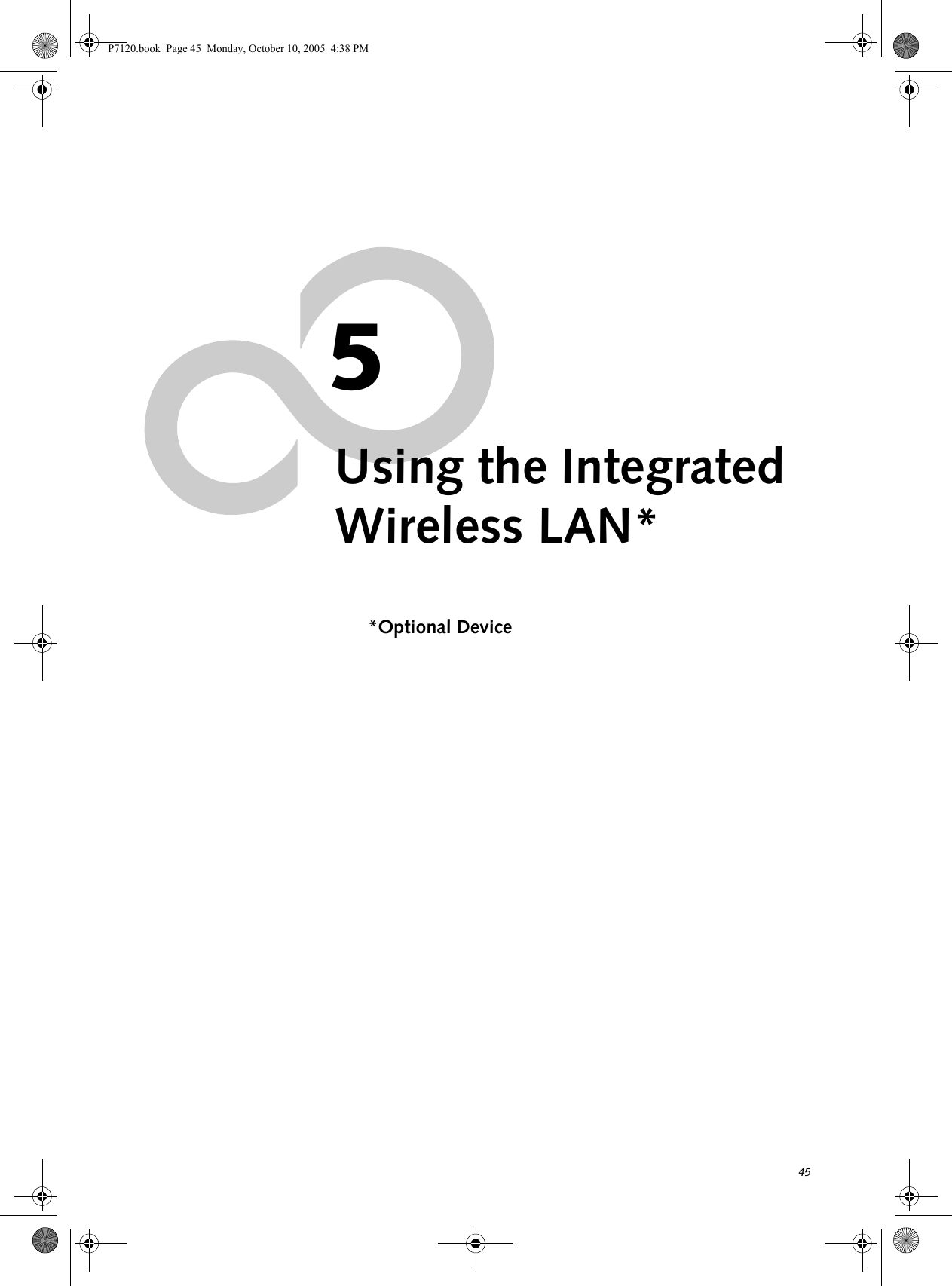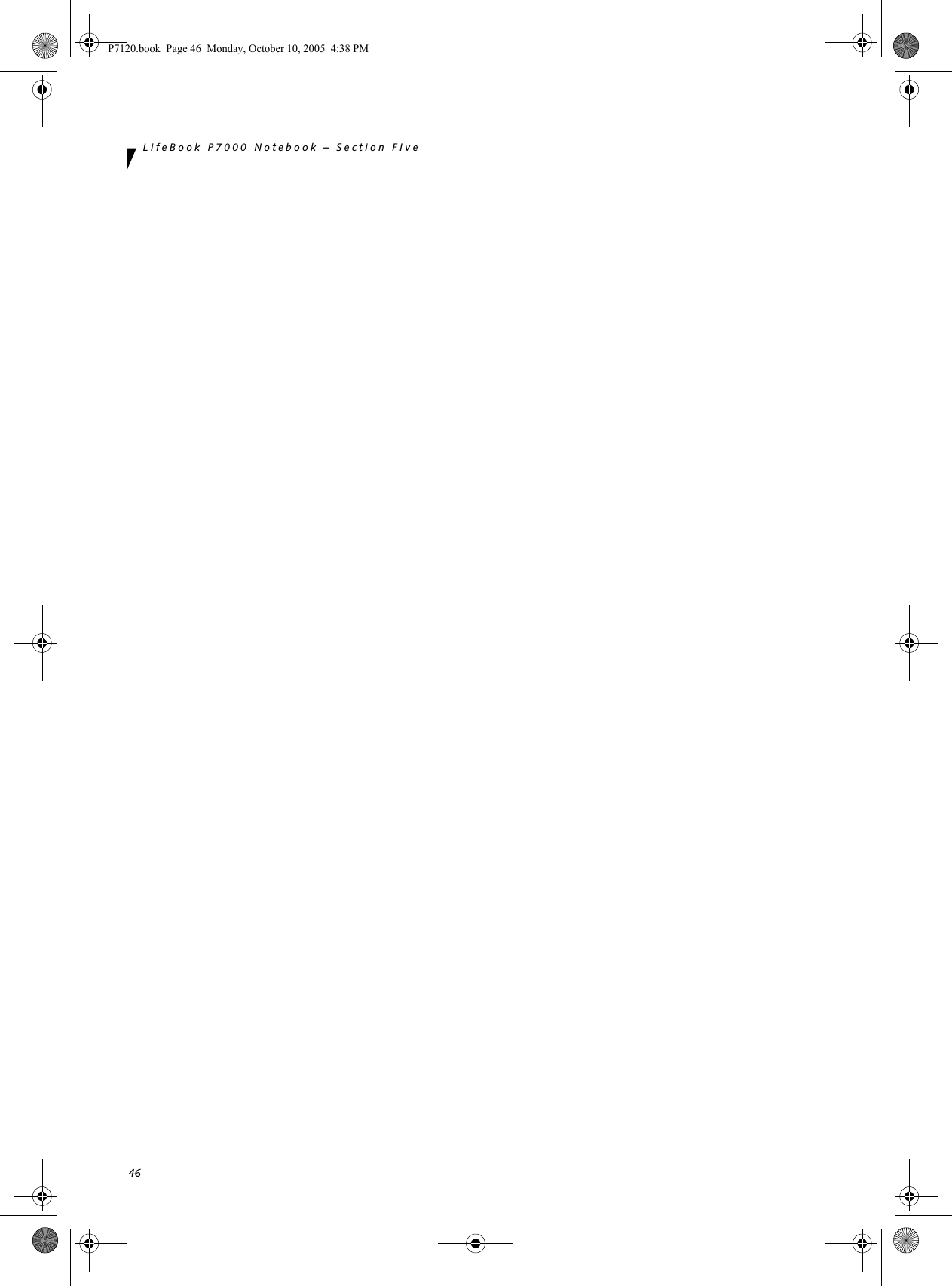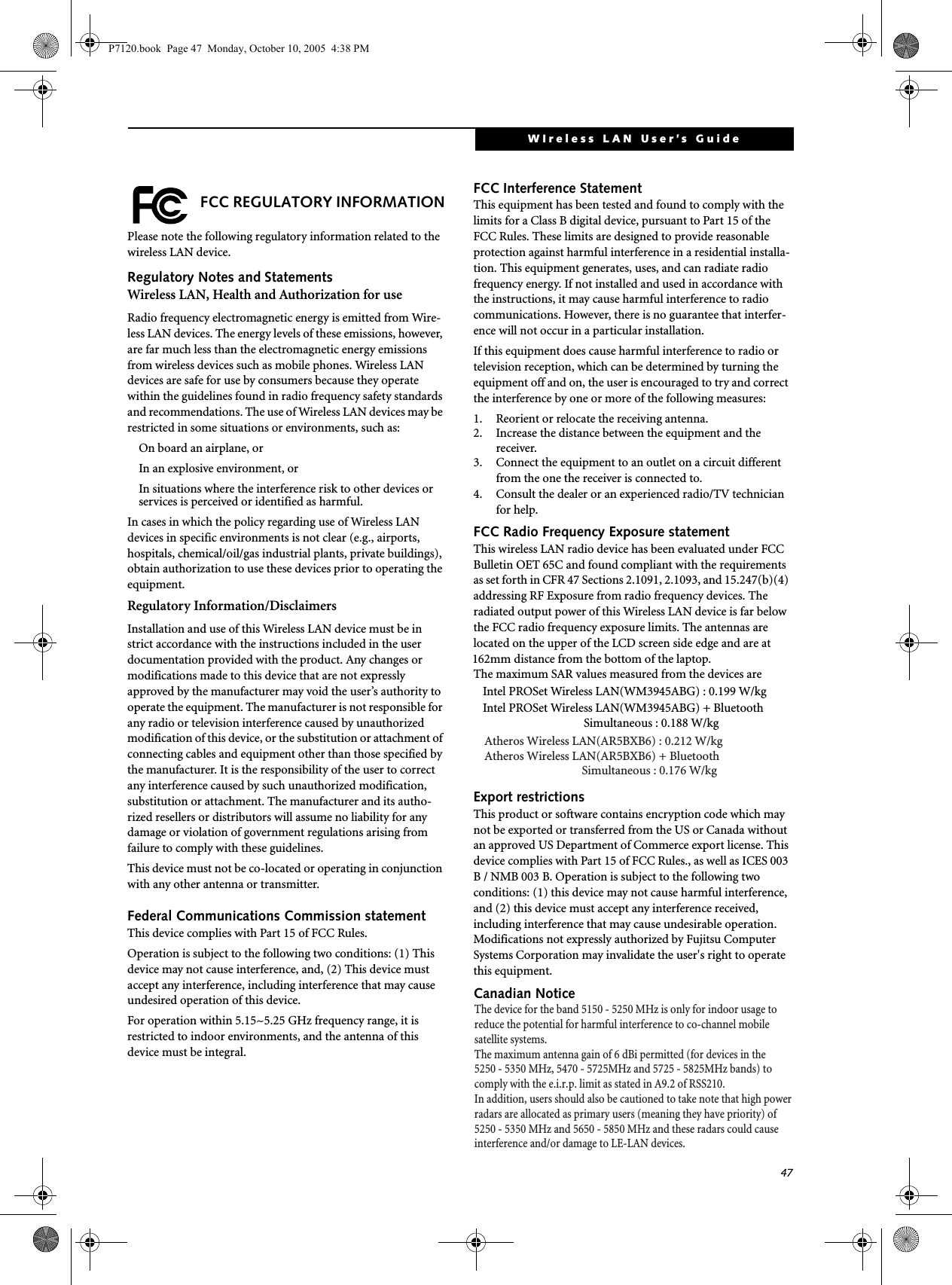Fujitsu Client Computing WB0045 LIFEBOOK P SERIES WITH AR5BXB6 11ABG WLAN & BT User Manual USERS MANUAL
Fujitsu Limited LIFEBOOK P SERIES WITH AR5BXB6 11ABG WLAN & BT USERS MANUAL
Contents
- 1. USERS MANUAL
- 2. USERS MANUAL 1
- 3. USERS MANUAL 2
USERS MANUAL
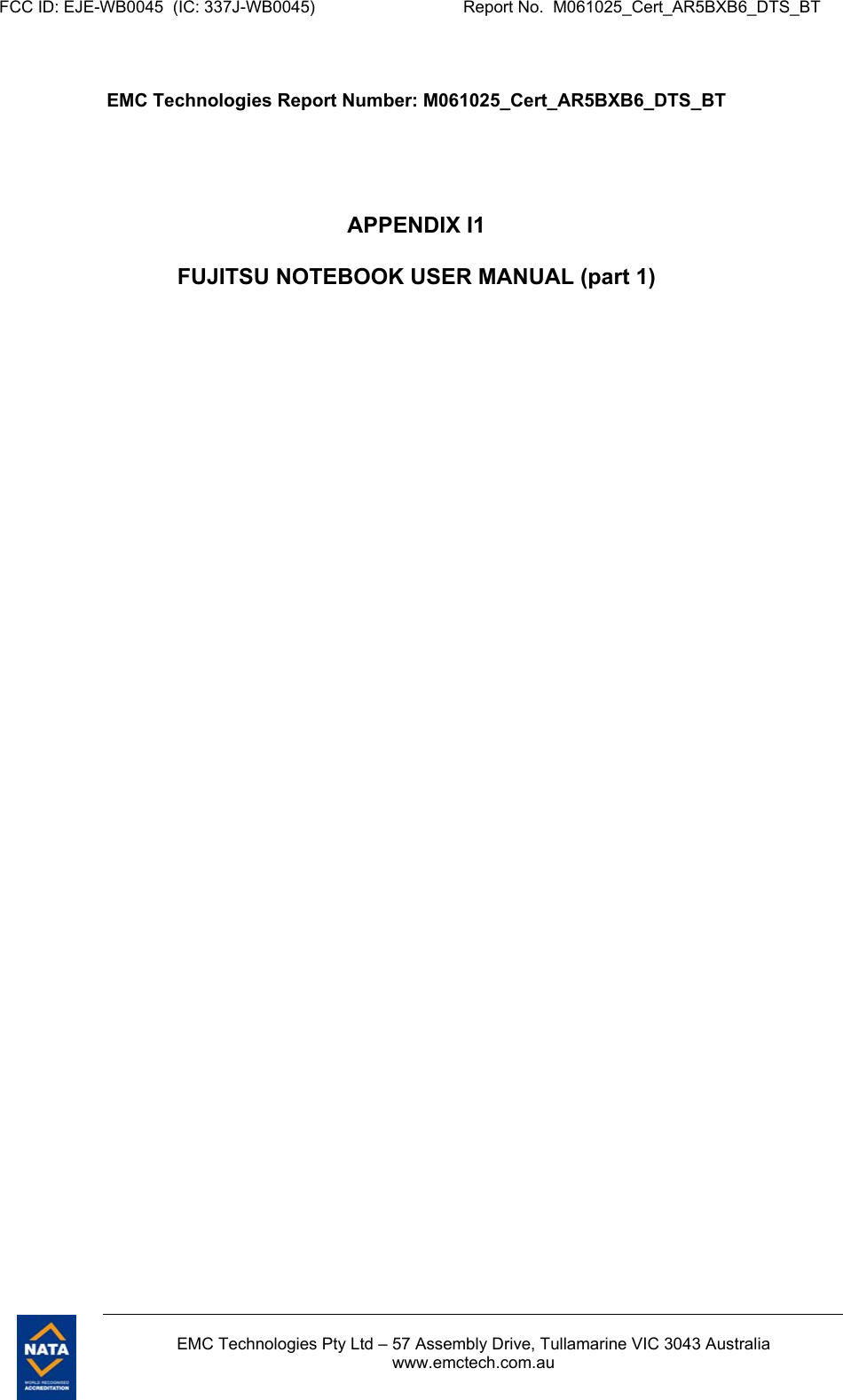
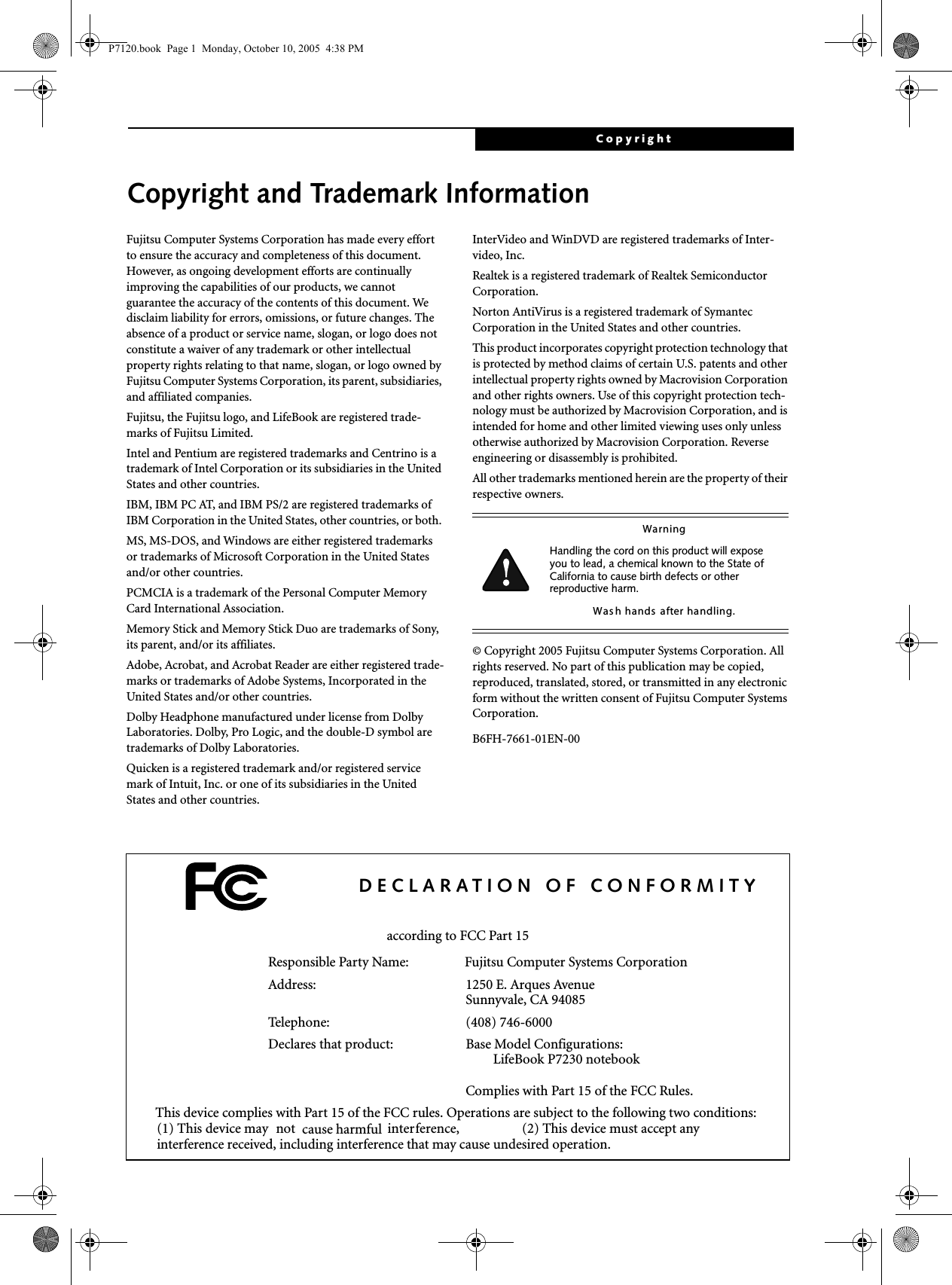
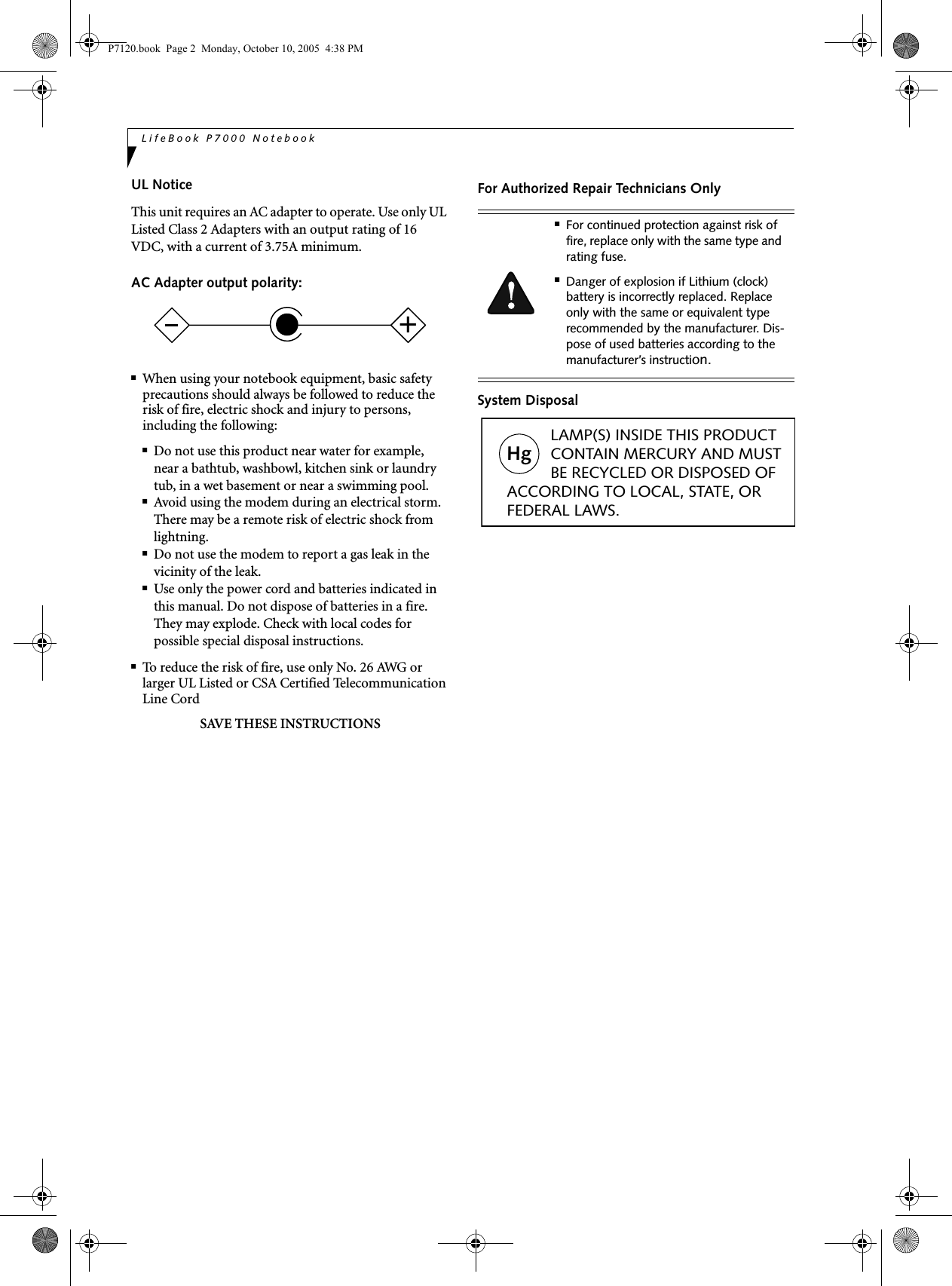
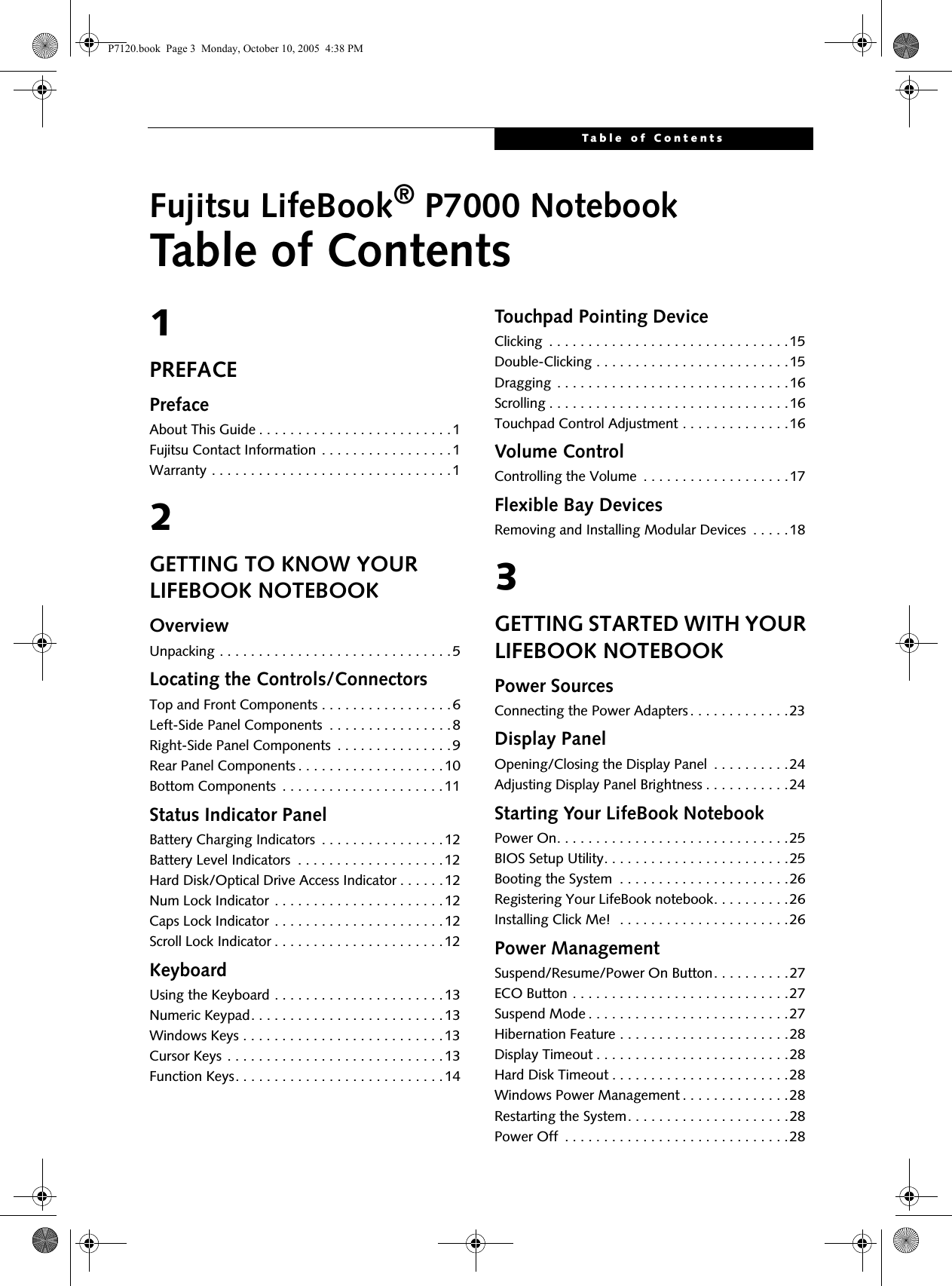
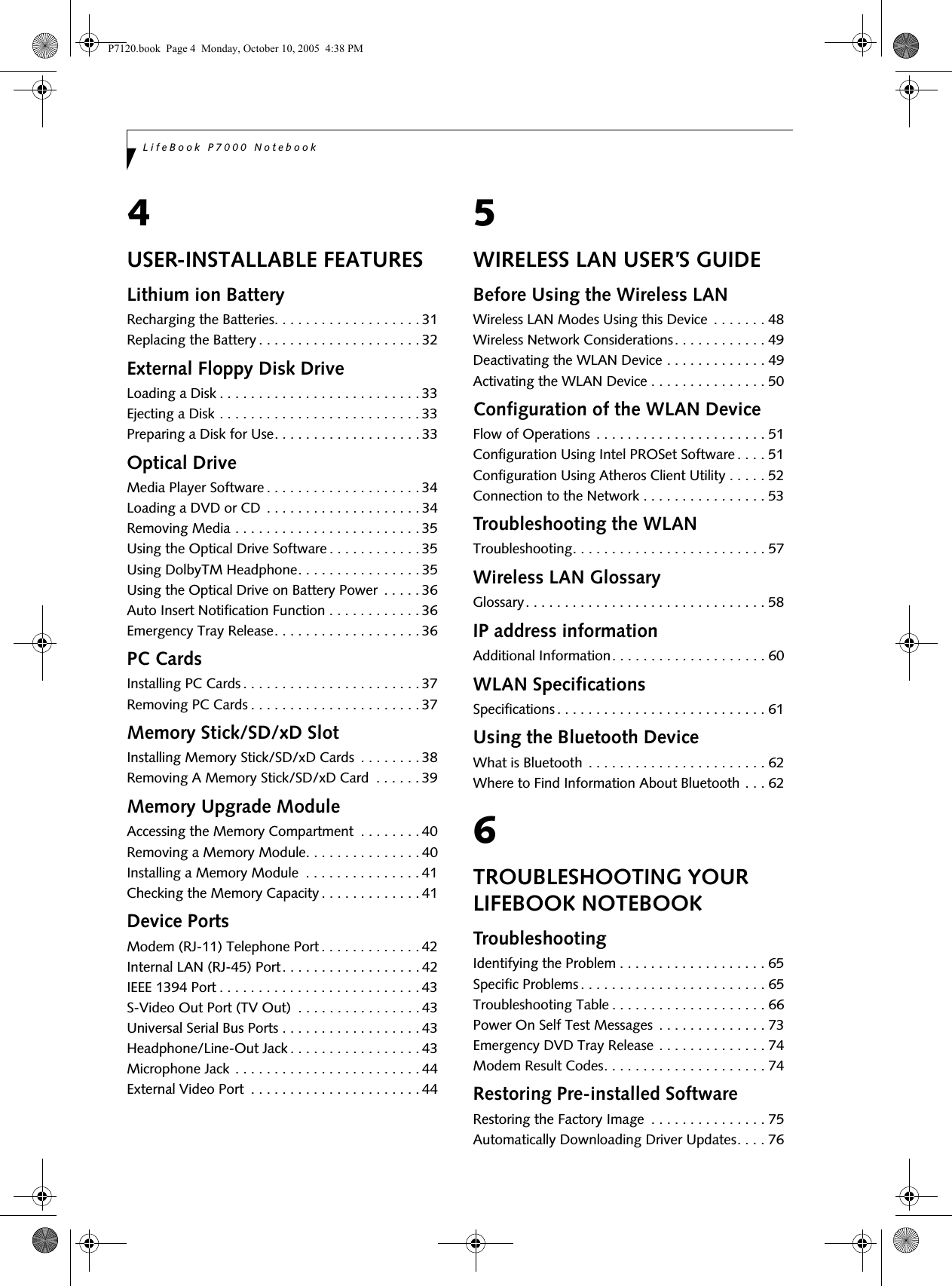

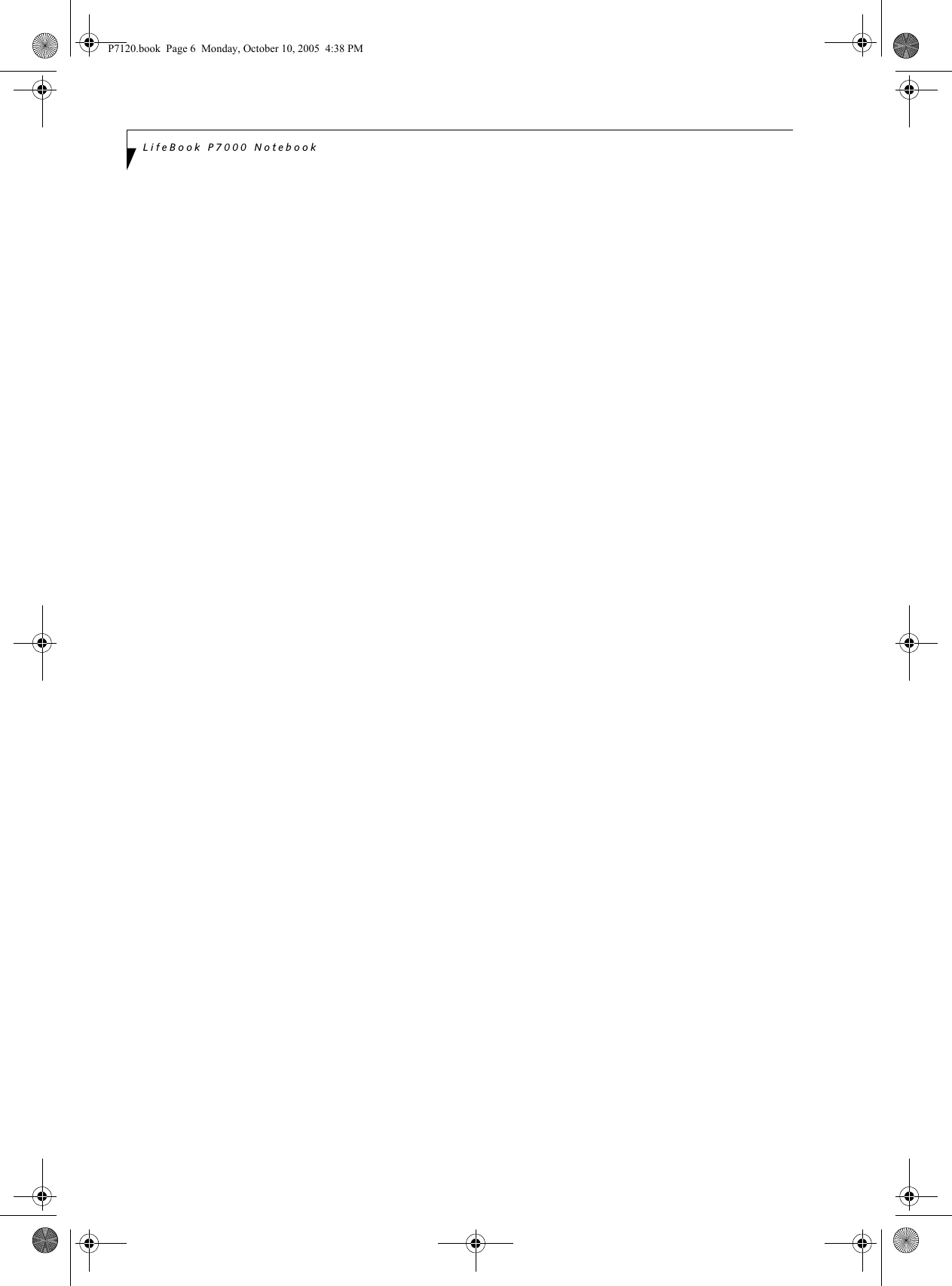

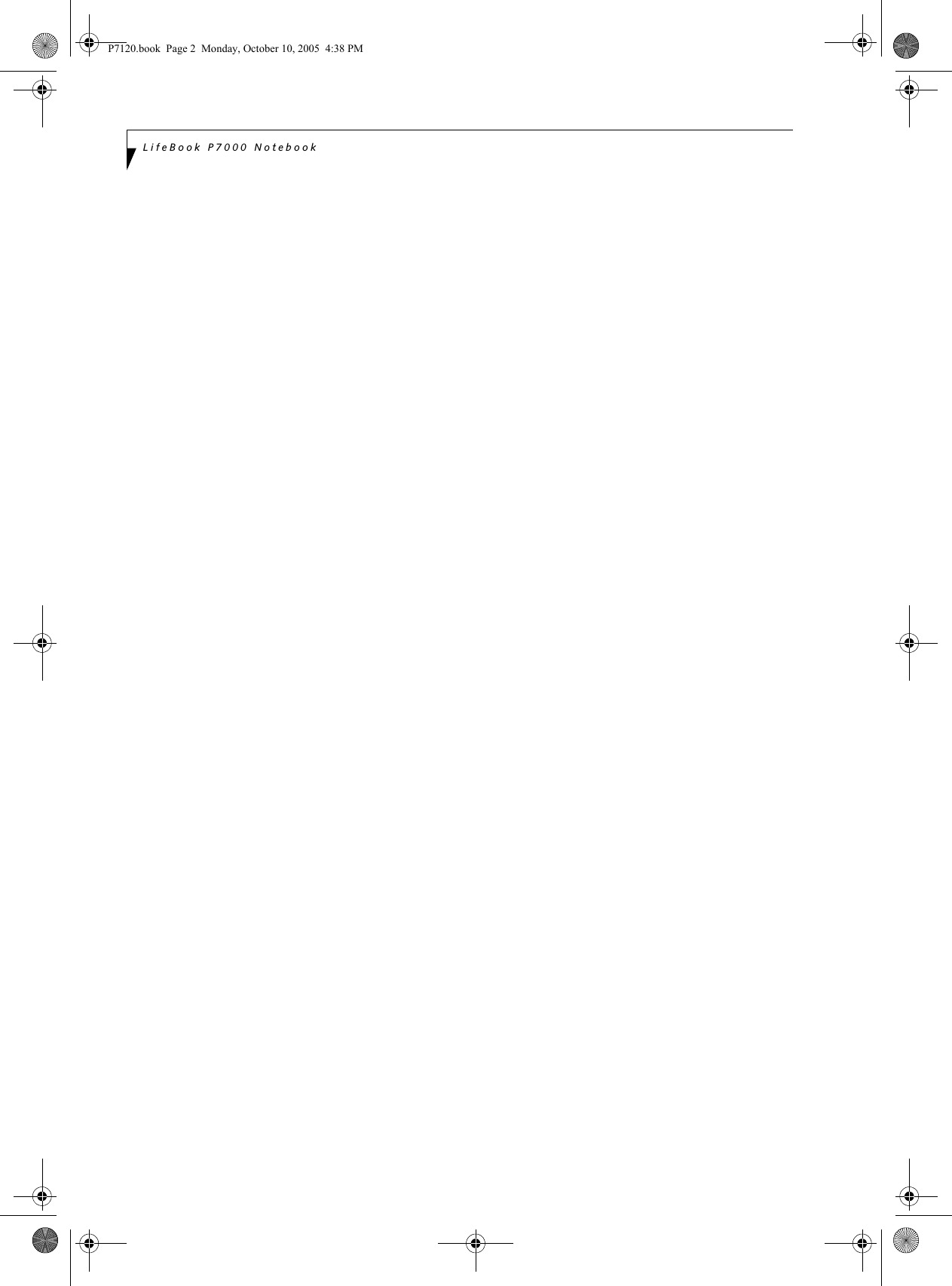
![1PrefacePrefaceABOUT THIS GUIDEThe LifeBook P7120/P7120D Series notebook from Fujitsu Computer Systems Corporation is a small but powerful computer. It is powered by an Intel Pentium M Ultra Low Voltage (ULV) processor, has a built-in wide-aspect Crystal View color display, and brings the func-tionality of desktop personal computers (PCs) to a portable environment.This manual explains how to operate your LifeBook notebook’s hardware and built-in system software. It comes with Microsoft Windows® XP Home or Window XP Pro pre-installed.Conventions Used in the GuideKeyboard keys and on-screen buttons appear in brackets. Example: [Fn], [F1], [ESC], and [CTRL].Pages with additional information about a specific topic are cross-referenced within the text.Example: (See page xx.)DOS commands you enter appear in Courier type. Example: Shutdown the computer?FUJITSU CONTACT INFORMATIONService and SupportYou can contact Fujitsu Service and Support in the following ways:■Toll free: 1-800-8Fujitsu (1-800-838-5487)■E-mail: 8fujitsu@us.fujitsu.com ■Web site: http://www.computers.us.fujitsu.com/supportBefore you place the call, you should have the following information ready so that the customer support representative can provide you with the fastest possible solution:■Product name■Product configuration number■Product serial number■Purchase date■Conditions under which the problem occurred■Any error messages that have occurred■Type of device connected, if anyFujitsu OnlineYou can go directly to the online Fujitsu Product catalog for your LifeBook notebook by clicking on the Fujitsu Weblinks -> LifeBook Accessories Web site URL link, located in the Windows Start menu, or by going to www.shopfujitsu.com.You can also reach Fujitsu Service and Support online by clicking on the Fujitsu Weblinks -> Service and Support Web site URL link, located in the Windows Start menu.WARRANTYYour LifeBook notebook is backed by an International Limited Warranty. Check the service kit that came with your notebook for warranty terms and conditions.The information icon highlights information that will enhance your understanding of the subject material.The caution icon highlights information that is important to the safe operation of your computer, or to the integrity of your files. Please read all caution information carefully.The warning icon highlights information that can be hazardous to either you, your LifeBook notebook, or your files. Please read all warning information carefully.You must have an active internet connec-tion to use the online URL links.P7120.book Page 1 Monday, October 10, 2005 4:38 PM](https://usermanual.wiki/Fujitsu-Client-Computing/WB0045.USERS-MANUAL/User-Guide-725861-Page-10.png)


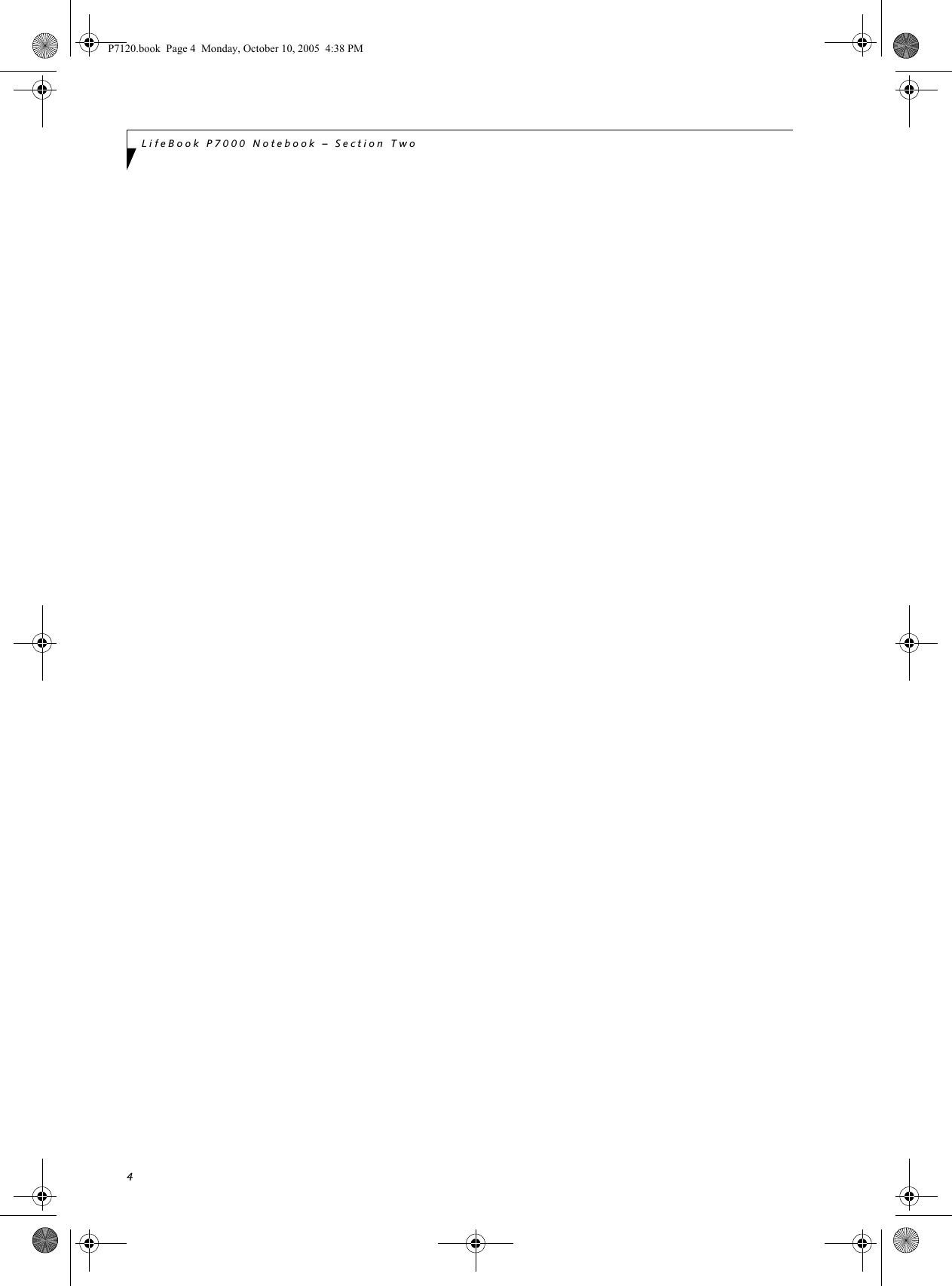
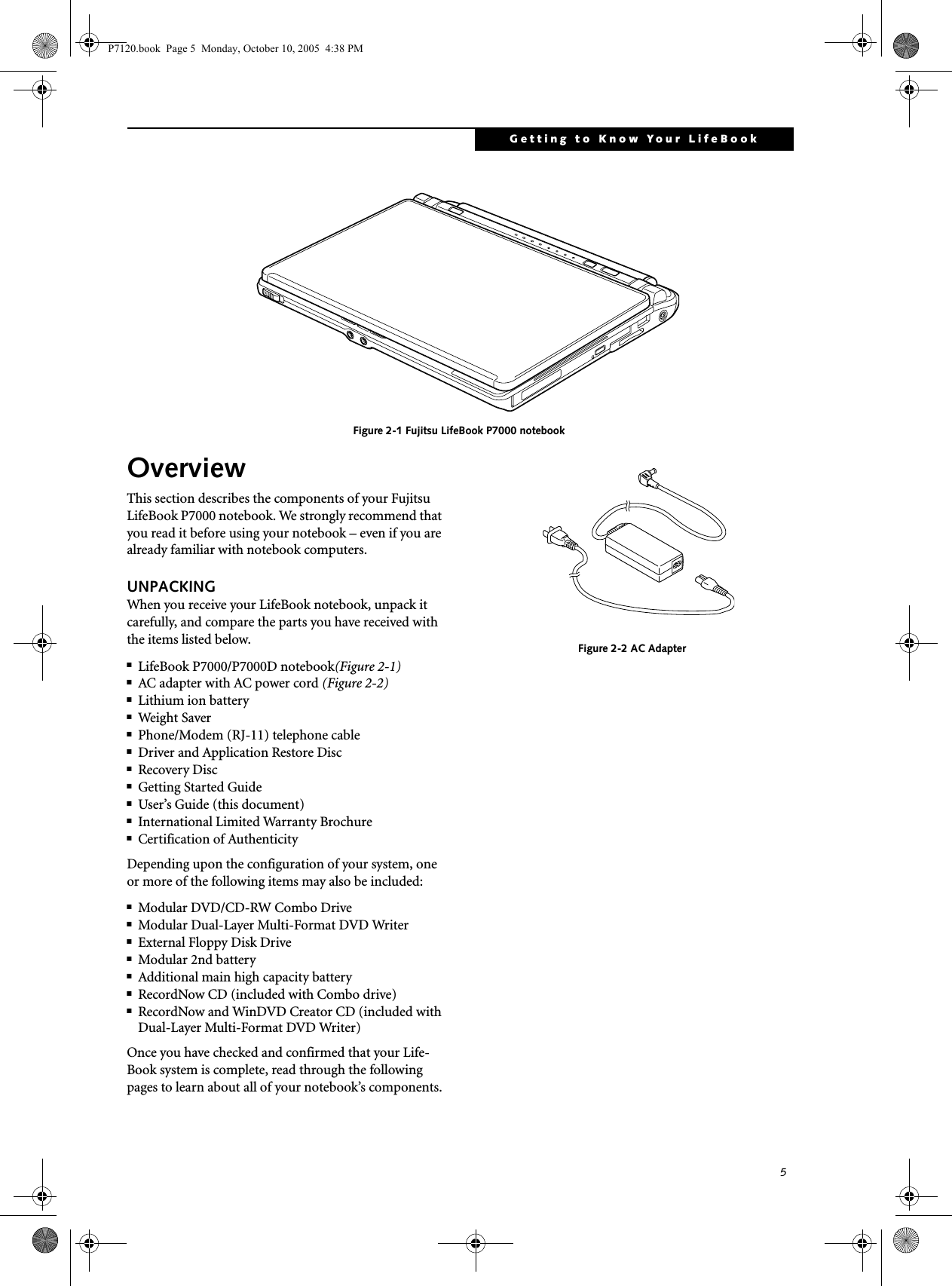


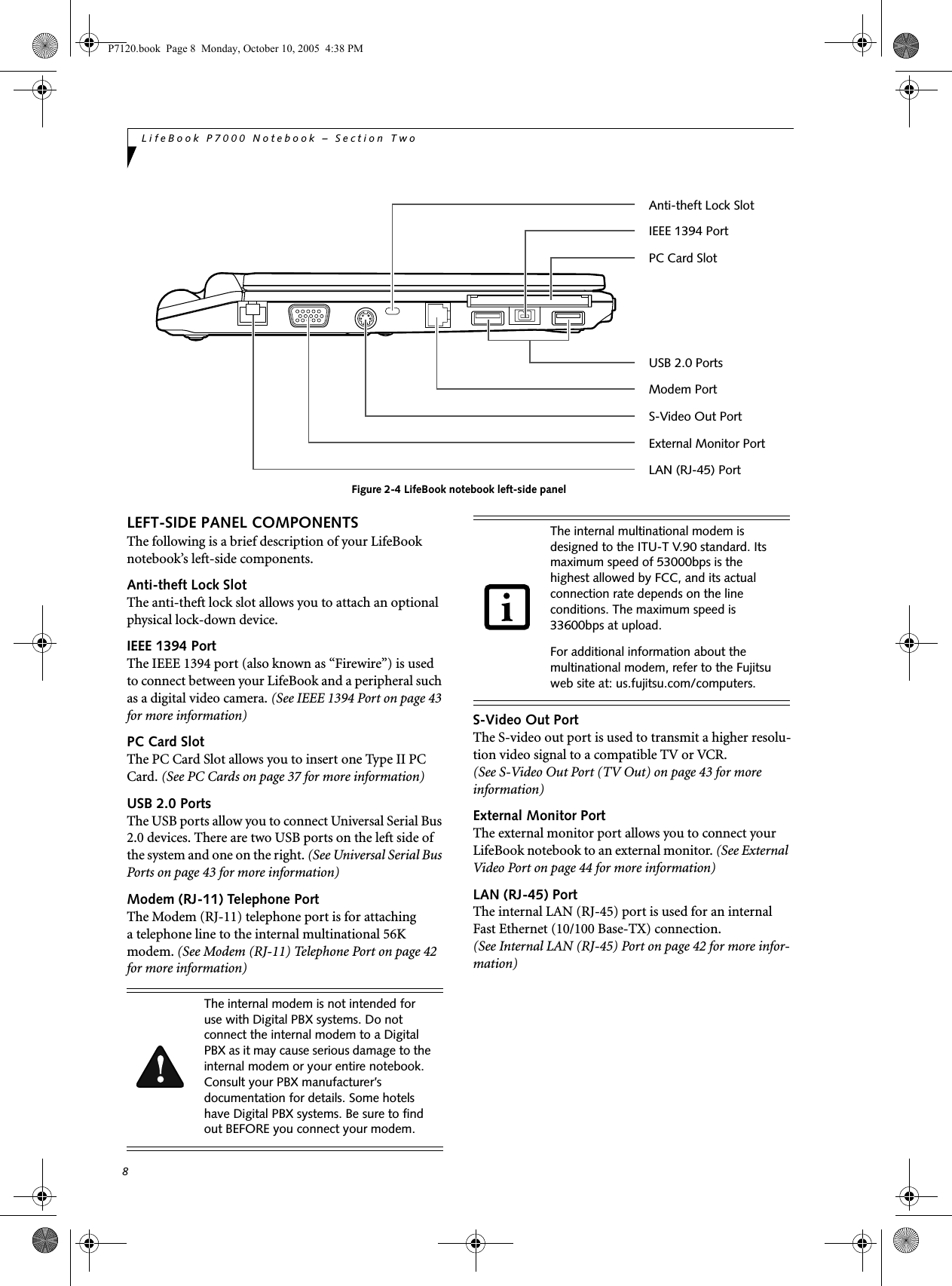

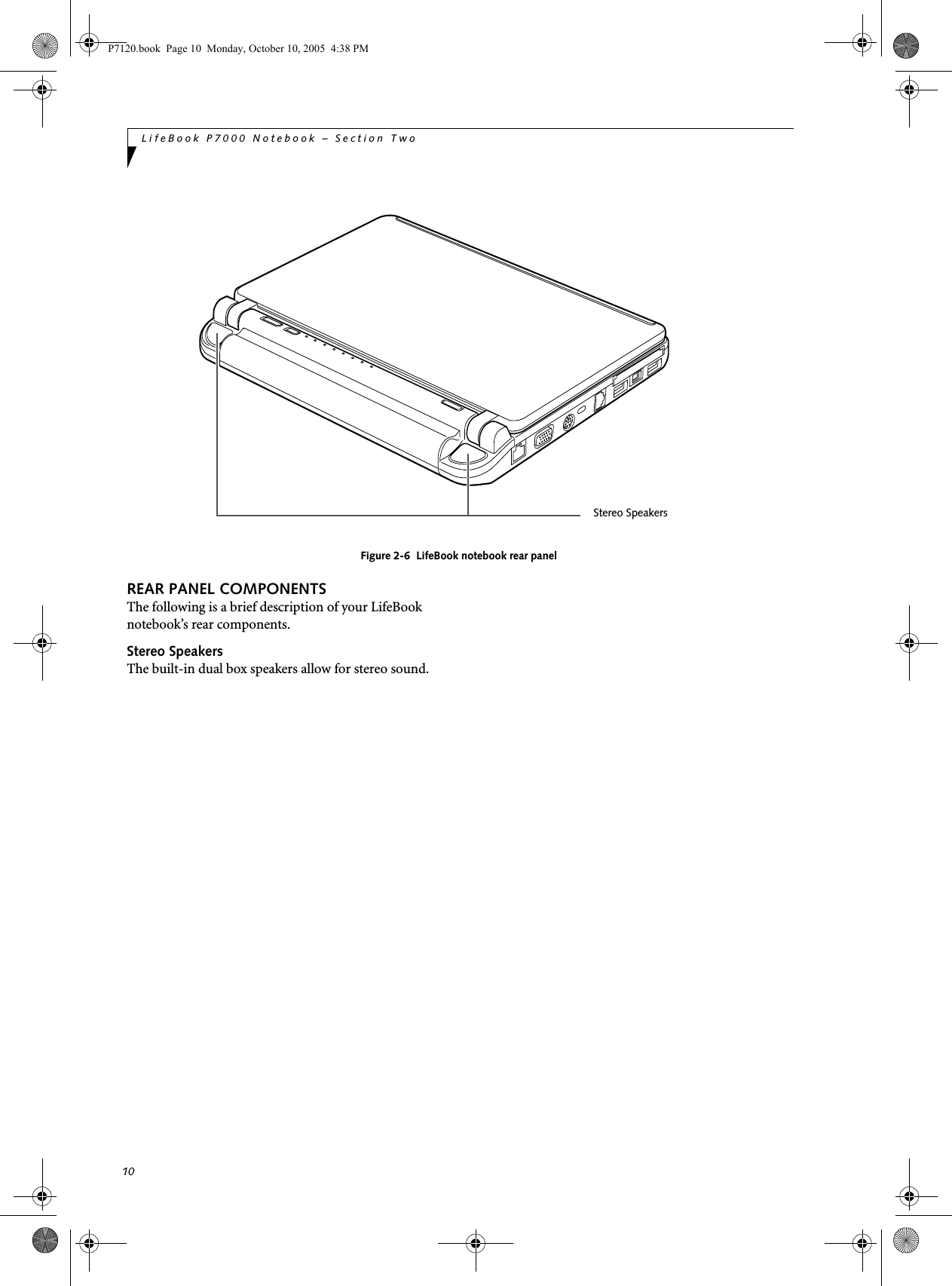
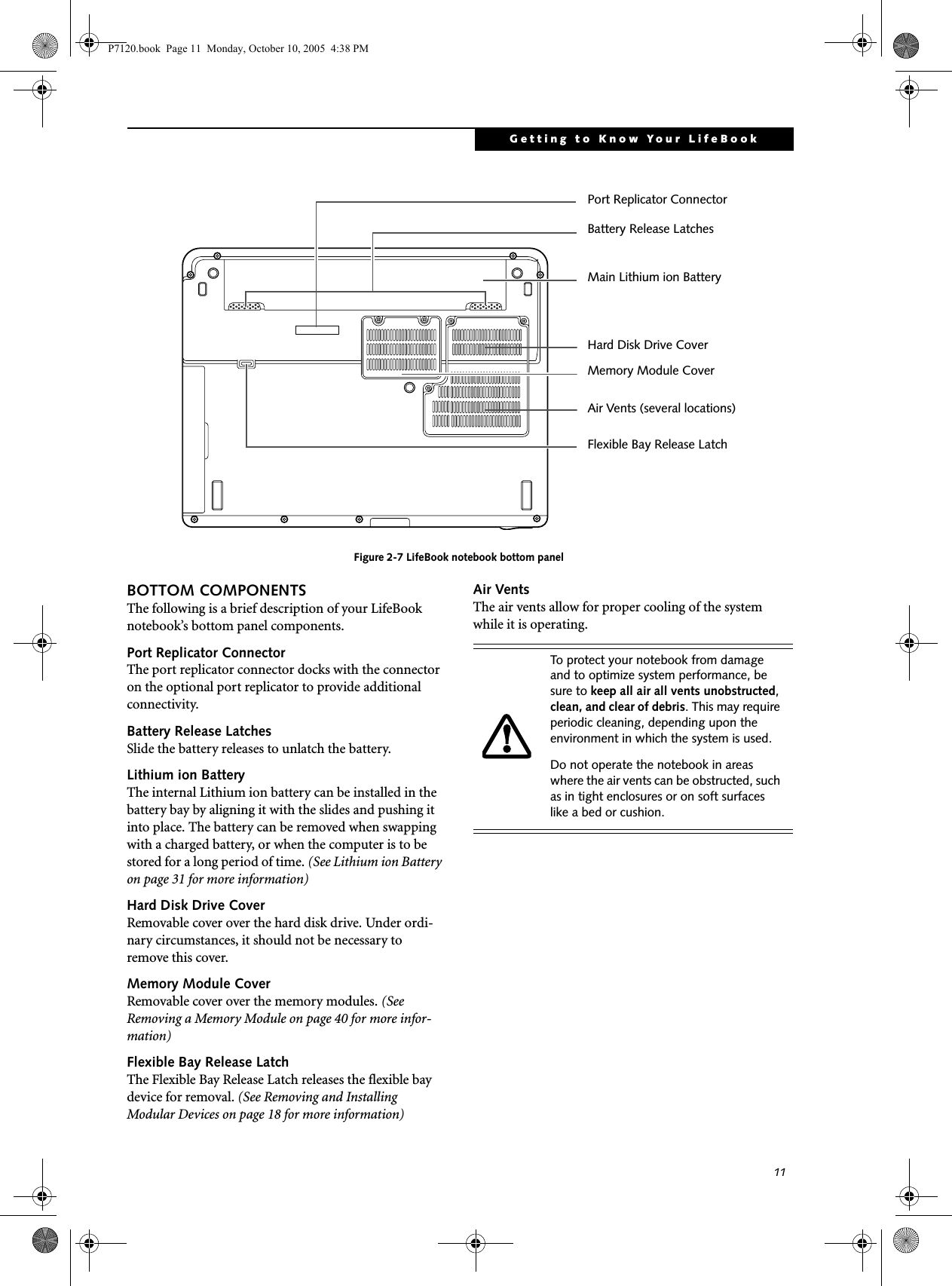
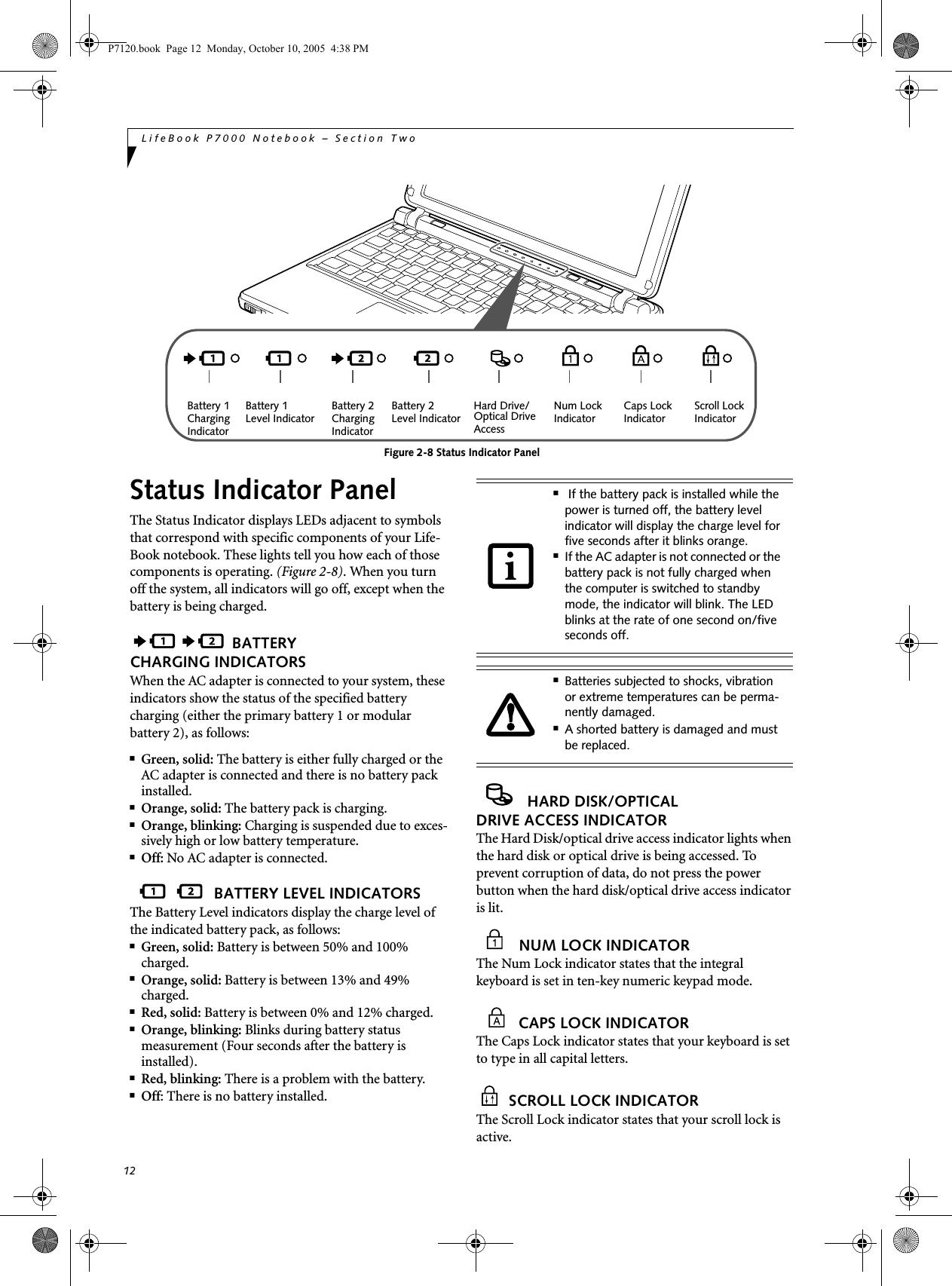
![13Getting to Know Your LifeBookFigure 2-9 KeyboardKeyboard USING THE KEYBOARDYour Fujitsu LifeBook notebook has an integral 82-key keyboard. The keys perform all the standard functions of a 101-key keyboard, including the Windows keys and other special function keys. This section describes the following keys. (Figure 2-9)■Numeric keypad: Your notebook allows certain keys to serve dual purposes, both as standard characters and as numeric and mathematical keys. The ability to tog-gle between the standard character and numerical keys is controlled through the [NumLk] key.■Cursor keys: Your keyboard contains four arrowkeys for moving the cursor or insertion point to the right, left, up, or down within windows, applications and documents. ■Function keys: The keys labeled [F1] through [F12], are used in conjunction with the [Fn] key to produce special actions that vary depending on what program is running. ■Windows keys: These keys work with your Windows operating system and function the same as the onscreen Start menu button, or the right buttonon your pointing device.NUMERIC KEYPADCertain keys on the keyboard perform dual functions as both standard character keys and numeric keypad keys. NumLk can be activated by pressing the [NumLk] keys. Turning off the NumLk feature is done the same way. Once this feature is activated you can enter numerals 0 through 9, perform addition ( + ), subtraction ( - ),multiplication ( * ), or division ( / ), and enter decimal points ( . ) using the keys designated as ten-key function keys. The keys in the numeric keypad are marked on the front edge of the key to indicate their secondary functions. WINDOWS KEYSYour LifeBook notebook has two Windows keys, consisting of a Start key and an Application key. The Start key displays the Start menu. This button functions the same as your onscreen Start menu button. The Application key functions the same as your right mouse button and displays shortcut menus for the selected item. (Please refer to your Windows documentation for additional information regarding the Windows keys.) CURSOR KEYSThe cursor keys are the four arrow keys on the keyboard which allow you to move the cursor up, down, left and right in applications. In programs such as Windows Explorer, it moves the “focus” (selects the next item up, down, left, or right). Fn Key WindowsFunction KeysNumeric KeypadCursor KeysWindowsApplication KeyStart Key P7120.book Page 13 Monday, October 10, 2005 4:38 PM](https://usermanual.wiki/Fujitsu-Client-Computing/WB0045.USERS-MANUAL/User-Guide-725861-Page-22.png)
![14LifeBook P7000 Notebook – Section TwoFUNCTION KEYSYour LifeBook notebook has 12 function keys, F1 through F12. The functions assigned to these keys differ for each application. You should refer to your software documentation to find out how these keys are used.The [Fn] key provides extended functions for thenotebook and is always used in conjunction with another key. ■[Fn+F3]: Pressing [F3] while holding [Fn] will toggle the Audio Mute on and off.■[Fn+F4]: Pressing [F4] while holding [Fn] will toggle the Quick Point feature on and off. Note that the [Fn+F4] combination only works if Manual Setting is selected in the BIOS. (See “Entering the BIOS Setup Utility” on page 25)■[Fn+F5]: Pressing [F5] while holding [Fn] allows you to toggle between video compensation and no compensation. (Video compensation controls spacing on the display. When it is enabled, displays with 1024 x 768 or 800 x 600 pixel resolution will still cover the entire screen.) Note that this function is only applicable if Compensation is disabled in the BIOS. (See BIOS Setup Utility on page 25 for more informa-tion).■[Fn+F6]: Pressing [F6] repeatedly while holding [Fn] will lower the brightness of your display.*■[Fn+F7]: Pressing [F7] repeatedly while holding [Fn] will increase the brightness of the display.*■[Fn+F8]: Pressing [F8] repeatedly while holding [Fn] will decrease the volume of your LifeBook note-book.**■[Fn+F9]: Pressing [F9] repeatedly while holding [Fn] will increase the volume of your LifeBook notebook.**■[Fn+F10]: Pressing [F10] while holding [Fn] allows you to change your selection of where to send your display video. Each time you press the combination of keys you will step to the next choice. The choices, in order, are: built-in display panel only, both built-in display panel and external monitor or external monitor only.* There are eight brightness levels.** There are 26 audio levels.P7120.book Page 14 Monday, October 10, 2005 4:38 PM](https://usermanual.wiki/Fujitsu-Client-Computing/WB0045.USERS-MANUAL/User-Guide-725861-Page-23.png)
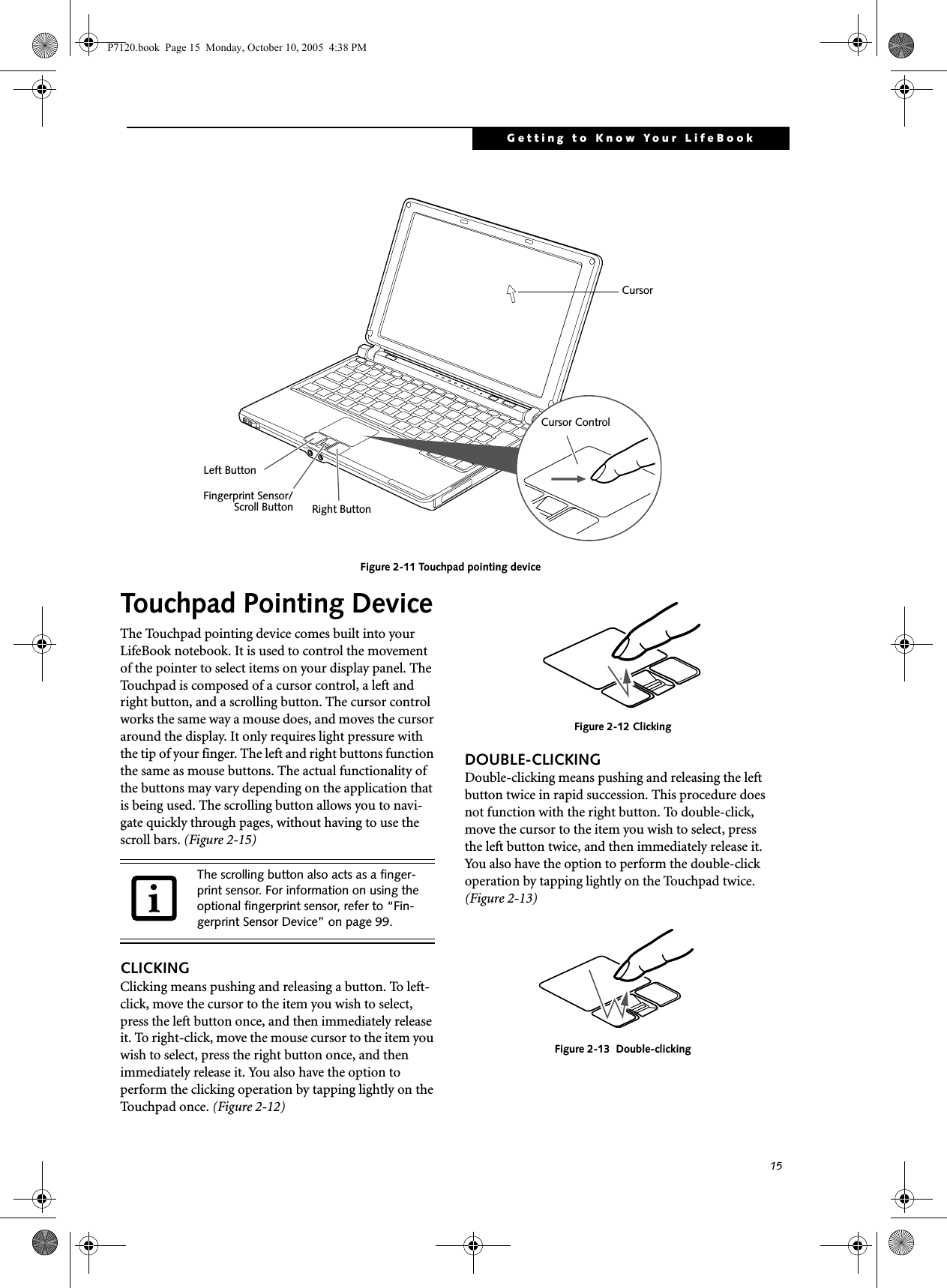
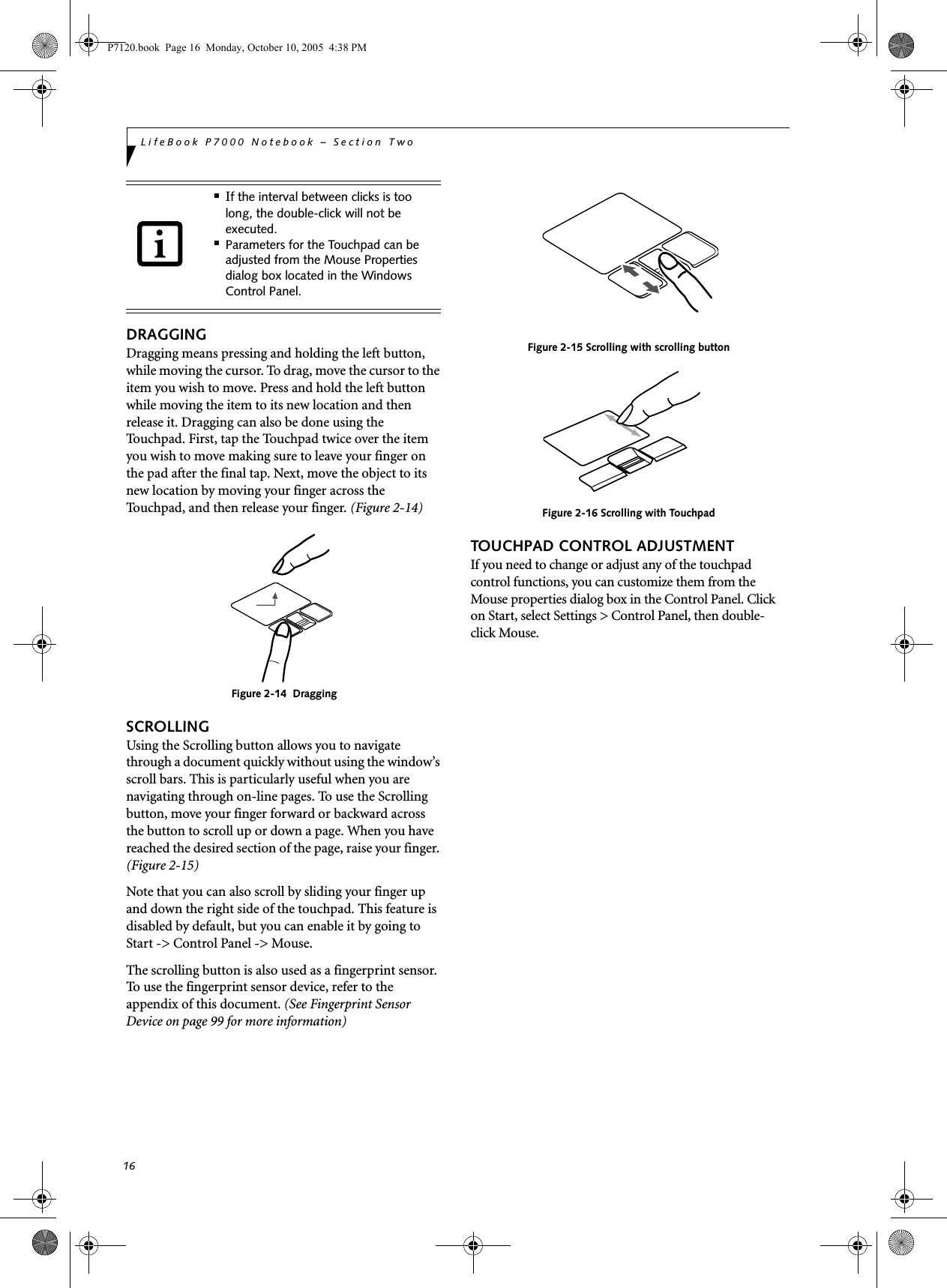
![17Getting to Know Your LifeBookVolume ControlYour Fujitsu LifeBook notebook has multiple volume controls which interact with each other. CONTROLLING THE VOLUMEThe volume can be controlled in several different ways:■Volume can be set from within the Volume Control on the Taskbar.■Volume can be controlled with the [F8] and [F9] functions keys. Pressing [F8] repeatedly while holding [Fn] will decrease the volume of your notebook. Press-ing [F9] repeatedly while holding [Fn] will increase the volume of your notebook.■Volume can be controlled by many volume controls that are set within individual applications.■Certain external audio devices you might connect to your system may have hardware volume controls.Each source discussed above puts an upper limit on the volume level that must then be followed by the other sources. We recommend that you experiment with the various volume controls to discover the optimal sound level.Any software that contains audio files will also contain a volume control of its own. If you install an external audio device that has an independent volume control, the hardware volume control and the software volume control will interact with each other. It should be noted that if you set your software volume to Off, you will override external volume control settings. There are 26 levels through which the function keys cycle. P7120.book Page 17 Monday, October 10, 2005 4:38 PM](https://usermanual.wiki/Fujitsu-Client-Computing/WB0045.USERS-MANUAL/User-Guide-725861-Page-26.png)
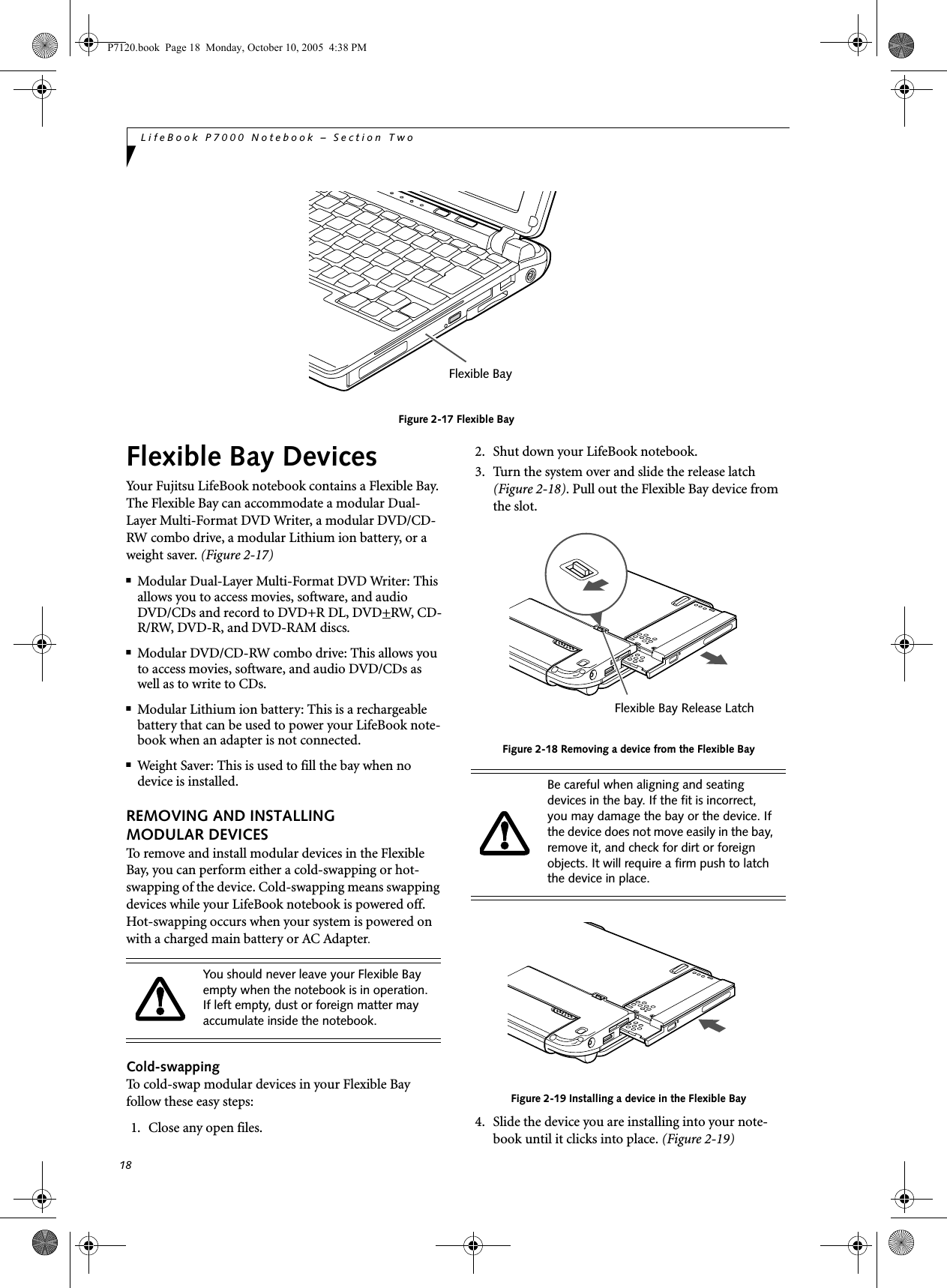
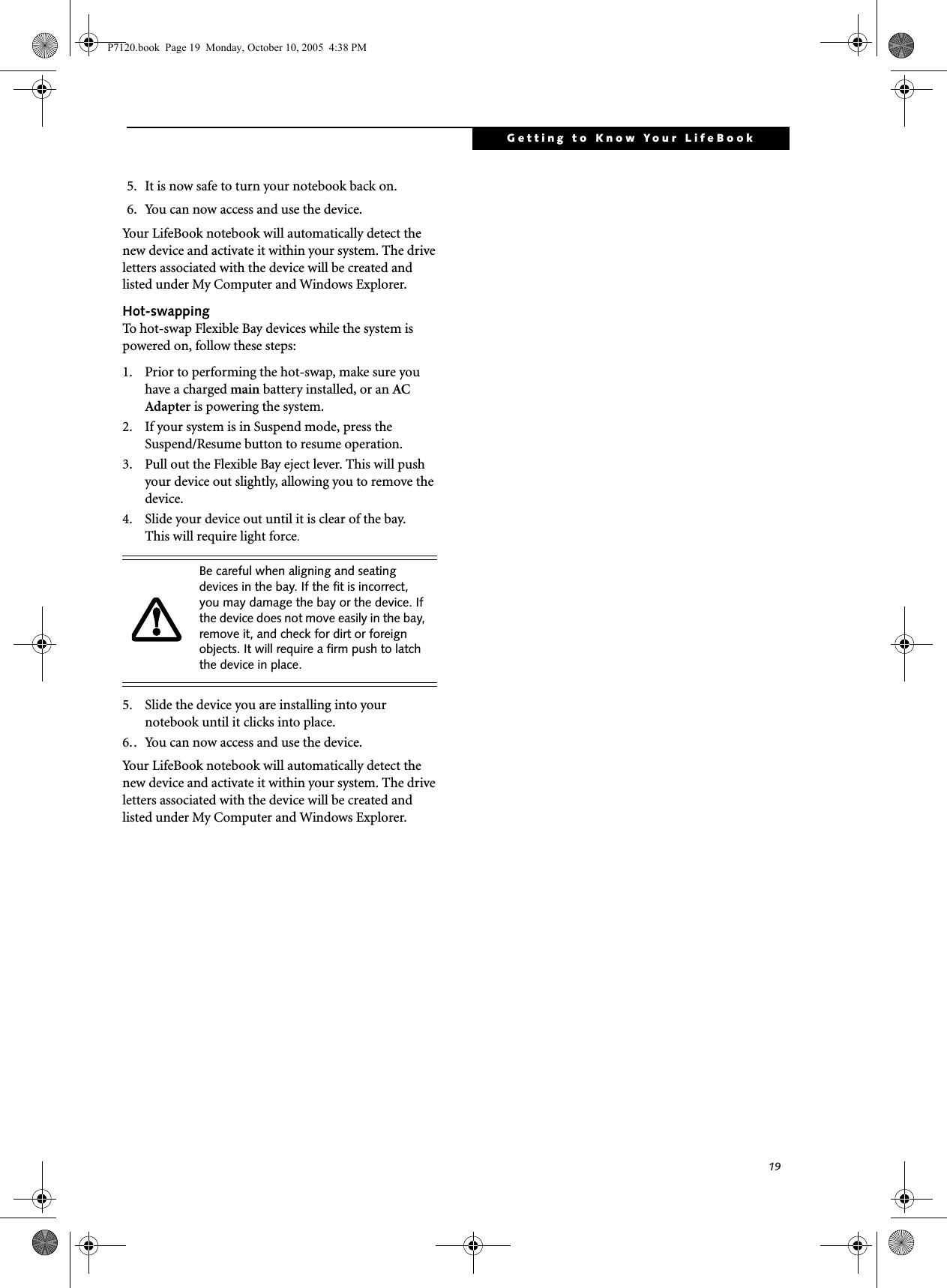

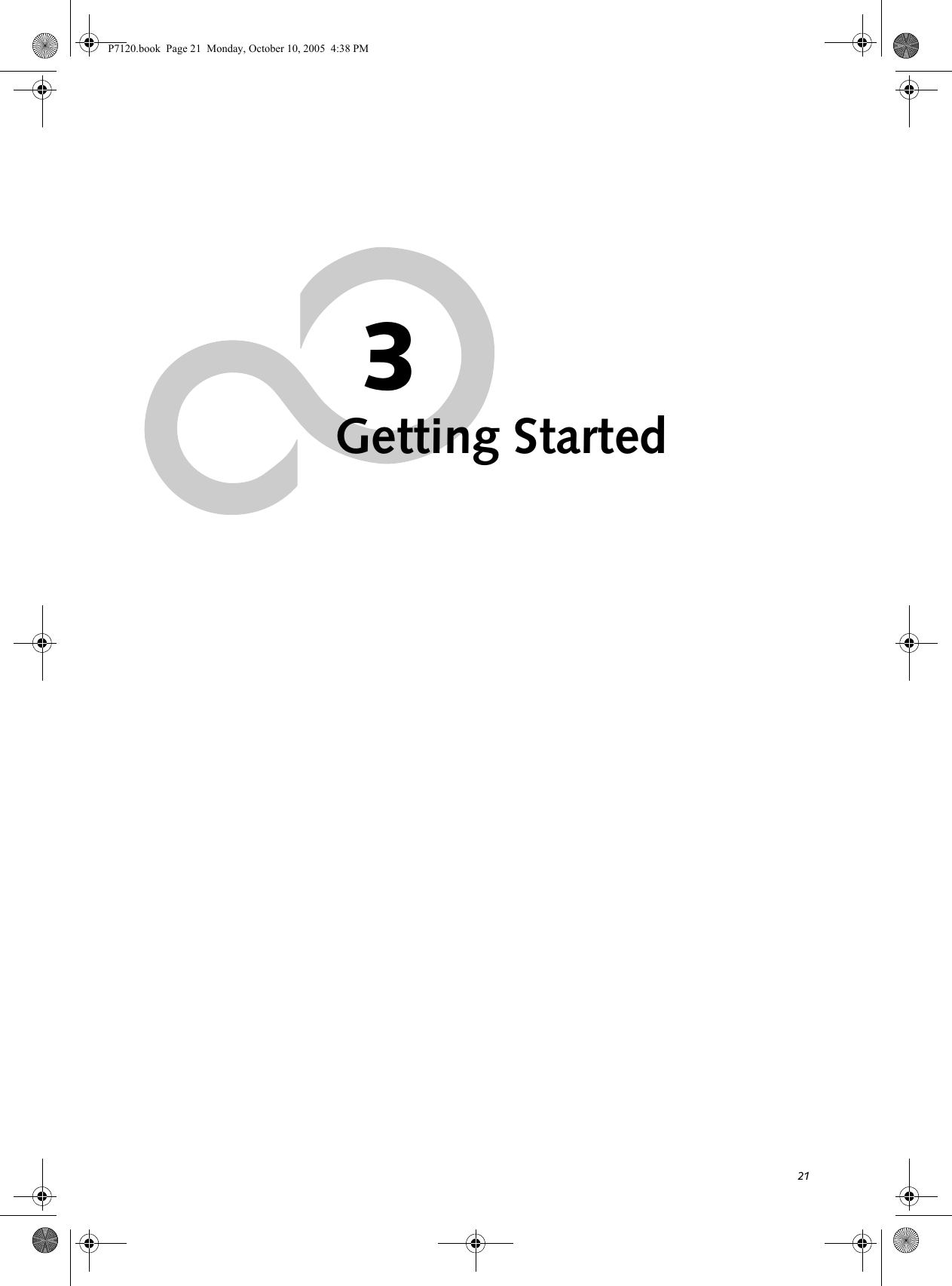
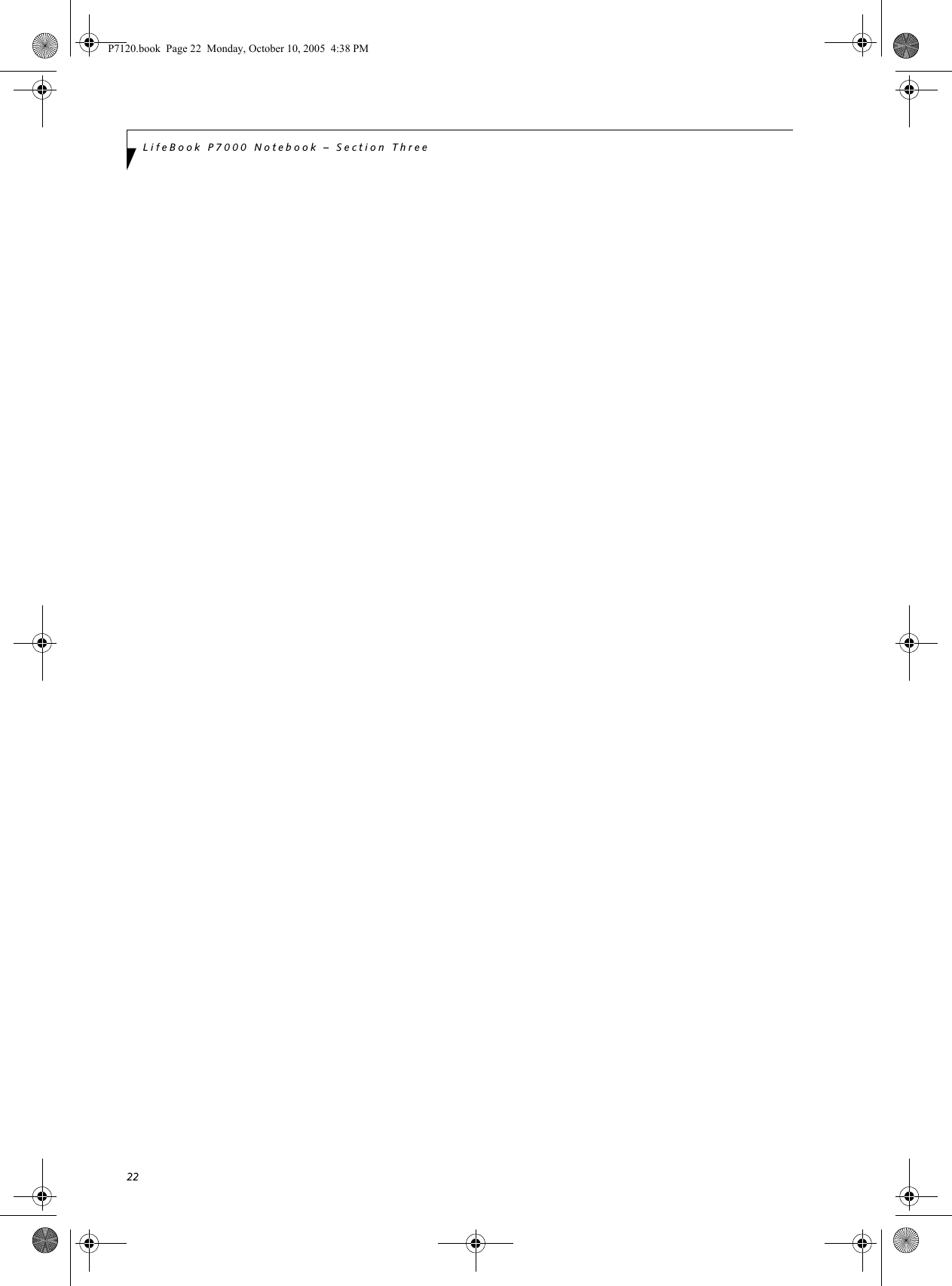
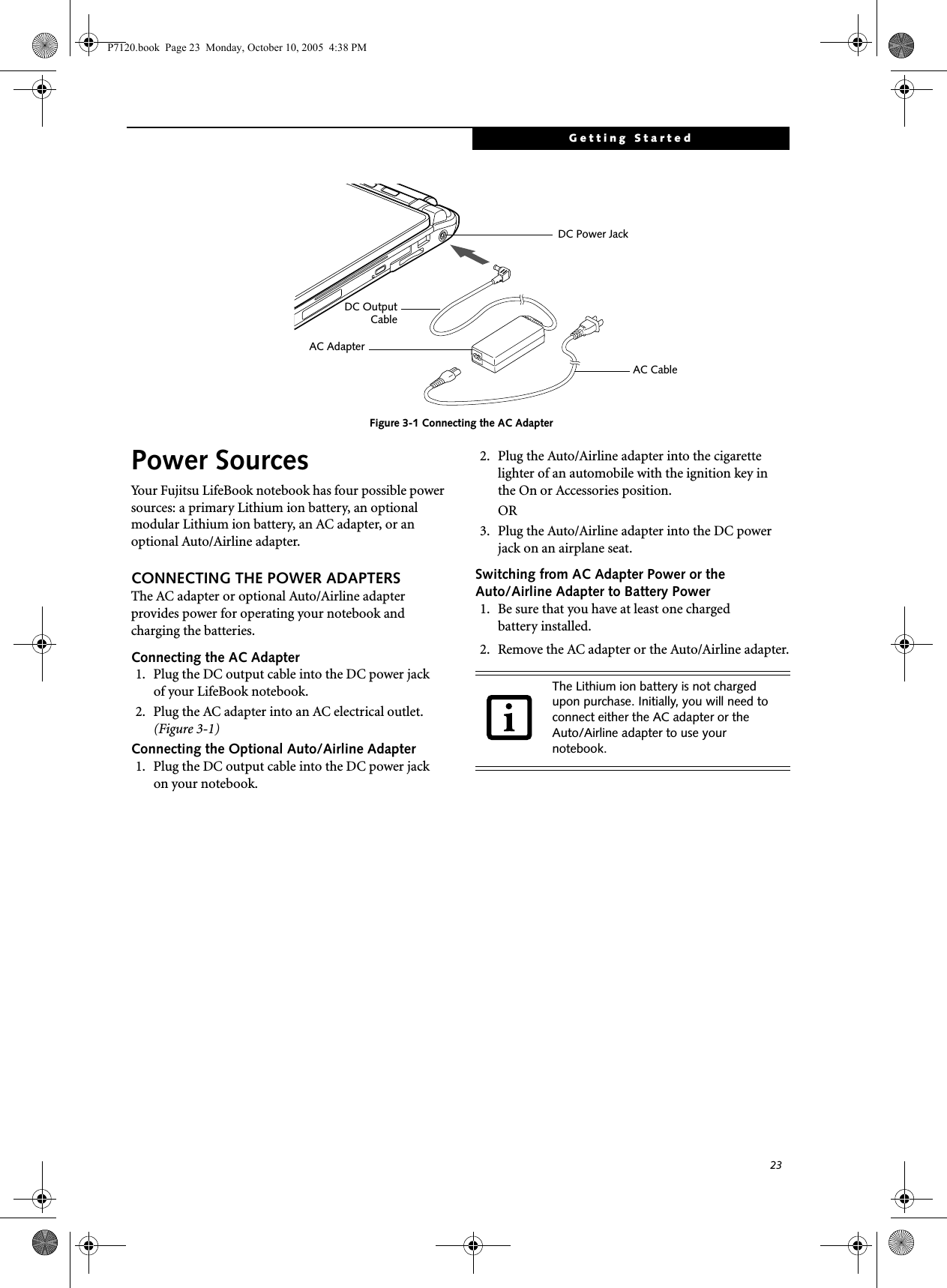
![24LifeBook P7000 Notebook – Section ThreeFigure 3-2 Opening the Display PanelDisplay PanelYour Fujitsu LifeBook notebook contains a display panel that is backlit for easier viewing in bright environments and maintains top resolution through the use of active-matrix technology. OPENING THE DISPLAY PANELLift the display backwards, being careful not to touch the screen, until it is at a comfortable viewing angle. (Figure 3-2)ADJUSTING DISPLAY PANEL BRIGHTNESSOnce you have turned on your LifeBook notebook, you may want to adjust the brightness level of the screen to a more comfortable viewing level. The brightness can be adjusted to eight different levels. There are two ways to adjust the brightness, by using the keyboard or the power management utility. Using the KeyboardAdjusting the brightness using the keyboard changes the setting only temporarily. ■[Fn+F6]: Pressing repeatedly will lower the brightness of your display.■[Fn+F7]: Pressing repeatedly will increase thebrightness of the display.CLOSING THE DISPLAY PANELHolding the edge of your display panel, pull it forward until it is flush with the body of your LifeBook notebook. P7120.book Page 24 Monday, October 10, 2005 4:38 PM](https://usermanual.wiki/Fujitsu-Client-Computing/WB0045.USERS-MANUAL/User-Guide-725861-Page-33.png)
![25Getting StartedStarting Your LifeBook NotebookPOWER ONSuspend/Resume/Power On buttonThe Suspend/Resume/Power On button is used to turn on your LifeBook notebook from its off state. Once you have connected your AC adapter or charged the internal Lithium ion Battery, you can power on your notebook. Figure 3-3 Pressing the suspend/resume/power buttonPress the Suspend/Resume/Power On button that is adjacent to the status indicator panel (Figure 3-3). When you are done working you can either leave your LifeBook notebook in Suspend mode, (See Suspend Mode on page 27 for more information), or you can turn it off. (See Power Off on page 28 for more information)When turn on your LifeBook notebook, it will perform a Power On Self Test (POST) to check the internal parts and configuration for correct functionality. If a fault is found, your LifeBook notebook will emit an audio warning and/or an error message will be displayed. (See Power On Self Test Messages on page 73 for more information) Depending on the nature of the problem, you may be able to continue by starting the operating system or by entering the BIOS setup utility and revising the settings.After satisfactory completion of the Power On Self Test (POST), your notebook will load your operating system.BOOT SEQUENCEThe procedure for starting-up your notebook is termed the Bootup sequence and involves your notebook’s BIOS. When your LifeBook notebook is first turned on, the main system memory is empty, and it needs to find instructions to start up your notebook. This information is in the BIOS program. Each time you power up or restart your notebook, it goes through a boot sequence which displays a Fujitsu logo until your operating system is loaded. During booting, your notebook is performing a standard boot sequence including a Power On Self Test (POST). When the boot sequence is completed without a failure and without a request for the BIOS Setup Utility, the system displays the operating system’s opening screen.The boot sequence is executed when:■You turn on the power to your LifeBook notebook.■You restart your notebook from the WindowsShut Down dialog box.■The software initiates a system restart. Example:When you install a new application.■You reset the system by pressing the three keys [CTRL+ALT+DEL]. BIOS SETUP UTILITYThe BIOS Setup Utility is a program that sets up the operating environment for your LifeBook notebook. Your BIOS is set at the factory for normal operating conditions, therefore there is no need to set or change the BIOS’ environment to operate your notebook.The BIOS Setup Utility configures:■Device control feature parameters, such as changingI/O addresses and boot devices.■System Data Security feature parameters, such as passwords.Entering the BIOS Setup UtilityTo enter the BIOS Setup Utility do the following: 1. Turn on or restart your LifeBook notebook.2. Press the [F2] key once the Fujitsu logo appears on the screen. This will open the main menu of the BIOS Setup Utility with the current settings displayed.3. Press the [RIGHT ARROW] or [LEFT ARROW] key to scroll through the other setup menus to review or alter the current settings.When you turn on your LifeBook note-book be sure you have a battery installed and charged, or that the AC or Auto/Air-line adapter is connected and has power.Do not carry your LifeBook notebook around with the power on or subject it to shocks or vibration, as you risk damaging your notebook.Suspend/Resume/Power On ButtonNever turn off your LifeBook notebook during the Power On Self Test (POST) or it will cause an error message to be displayed the next time you turn on your LifeBook notebook. (See Power On Self Test Mes-sages on page 73 for more information)P7120.book Page 25 Monday, October 10, 2005 4:38 PM](https://usermanual.wiki/Fujitsu-Client-Computing/WB0045.USERS-MANUAL/User-Guide-725861-Page-34.png)
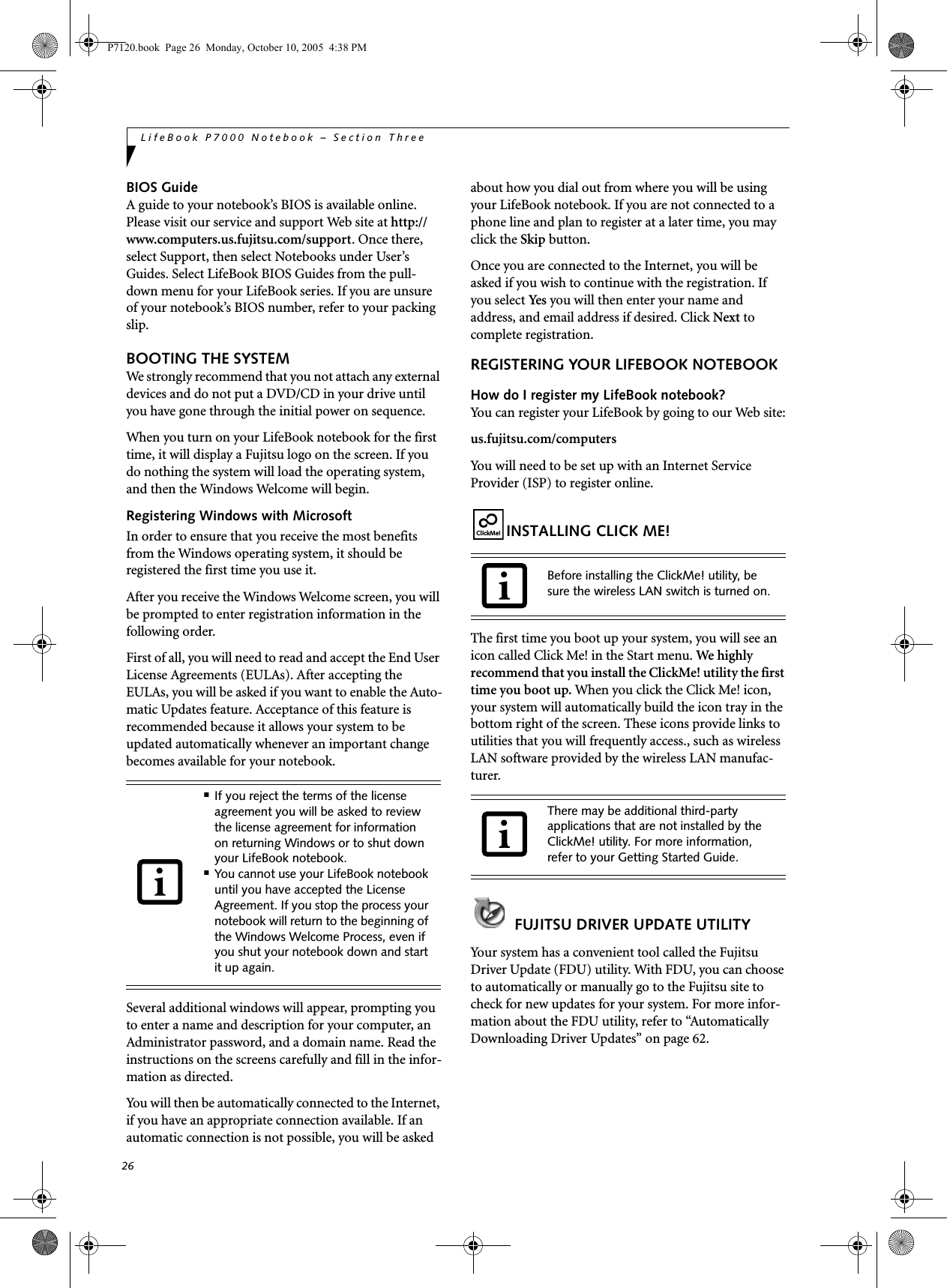
![27Getting StartedPower ManagementYour Fujitsu LifeBook notebook has many options and features for conserving battery power. Some of these features are automatic and need no user intervention, such as those for the internal modem. However, others depend on the parameters you set to best suit your oper-ating conditions, such as those for the display bright-ness. Internal power management for your notebook may be controlled from settings made in your operating system, pre-bundled power management application, or from settings made in BIOS setup utility.Besides the options available for conserving battery power, there are also some things that you can do to prevent your battery from running down as quickly.For example, you can create an appropriate power saving profile, put your notebook into Suspend mode when itis not performing an operation, and you can limit the use of high power devices. As with all mobile, battery powered computers, there is a trade-off betweenperformance and power savings.SUSPEND/RESUME/POWER ON BUTTONWhen your LifeBook notebook is active, the Suspend/Resume/Power On button can be used to manually put your notebook into Suspend mode. Push the button when your notebook is active, but not actively accessing anything, and immediately release the button. You will hear two short beeps and your system will enterSuspend mode. (See figure 2-3 on page 6 for location)If your LifeBook notebook is suspended, pushing the Suspend/Resume/Power On button will return your notebook to active operation. You can tell whether or not your system is in Suspend mode by looking at the Power indicator. (See figure 2-3 on page 6) If the indi-cator is visible and not flashing, your notebook is fully operational. If the indicator is both visible and flashing, your notebook is in Suspend mode. If the indicator is not visible at all, the power is off or your notebook is in Hibernation mode.ECO BUTTONThe ECO button is located to the right of the status indi-cator panel. The button is designed to extend system power by reducing the LCD brightness, shutting down the optical drive, PC Card, and IEEE 1394 functionality, and enabling the hard disk drive’s auto power off mode. Pressing the button again restores those functions.The settings for the ECO button can be changed in the Power Saving Utility Setup window. To open the window, use one of the three following methods:■Click [Start] -> [All Programs] -> [Power Saving Utility] -> [Setup - Power Saving Utility], or, ■Click [Start] -> [Control Panel] -> [Performance and Maintenance] -> [Power Options]. Click the Power Saving Utility tab and click [Change Settings] button, or,■Double-click the Power Saving Utility icon in the system tray at the bottom right of the screen. The Power Saving Utility Setting window will appear. SUSPEND MODESuspend or Standby mode in Windows saves the contents of your LifeBook notebook’s system memory during periods of inactivity by maintaining power to critical parts. This mode will turn off the CPU, the display, the hard drive, and all of the other internal components except those necessary to maintain system memory and allow for restarting. Your notebook can be put in Suspend mode by:■Pressing the Suspend/Resume/Power On button when your system is turned on.■Selecting Standby from the Windows Shut Down menu.■Timing out from lack of activity.■Allowing the battery to reach the Dead BatteryWarning condition.You can change the actions the computer takes when the lid is closed or buttons are pressed by clicking [Start] -> Control Panel. Double-click the Power Options icon and select the Advanced tab. Your LifeBook notebook’s system memory typically stores the file(s) on which you are working, open applica-tion(s) information, and any other data required to support the operation(s) in progress. When you resume operation from Suspend mode, your notebook will return to the point where it left off. You must use the Suspend/Resume/Power On button to resume operation, and there must be an adequate power source available, or your notebook will not resume.■If you are running your LifeBook note-book on battery power, be aware that the battery continues to discharge while your notebook is in Suspend mode, though not as fast as when fully opera-tional. ■Disabling the Suspend/Resume/Power On button prevents it from being used to put your LifeBook notebook in Suspend or Hibernation mode. The resume function of the button cannot be disabled.■If your LifeBook notebook is actively accessing information when you enter the Suspend or Hibernation mode, changes to open files are not lost. The files are left open and memory is kept active during Suspend mode or the memory is transferred to the internal hard drive during Hibernation mode.P7120.book Page 27 Monday, October 10, 2005 4:38 PM](https://usermanual.wiki/Fujitsu-Client-Computing/WB0045.USERS-MANUAL/User-Guide-725861-Page-36.png)
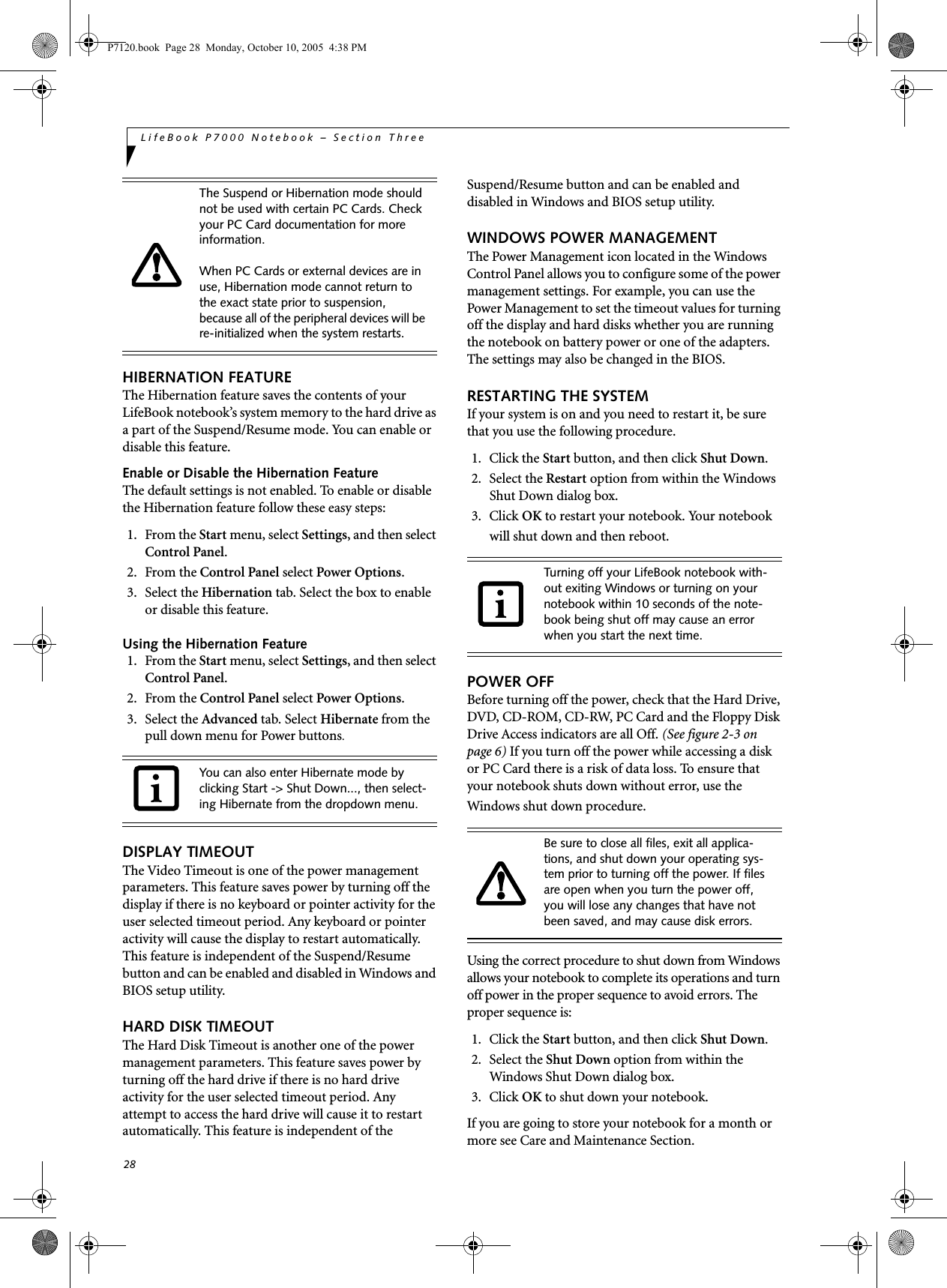
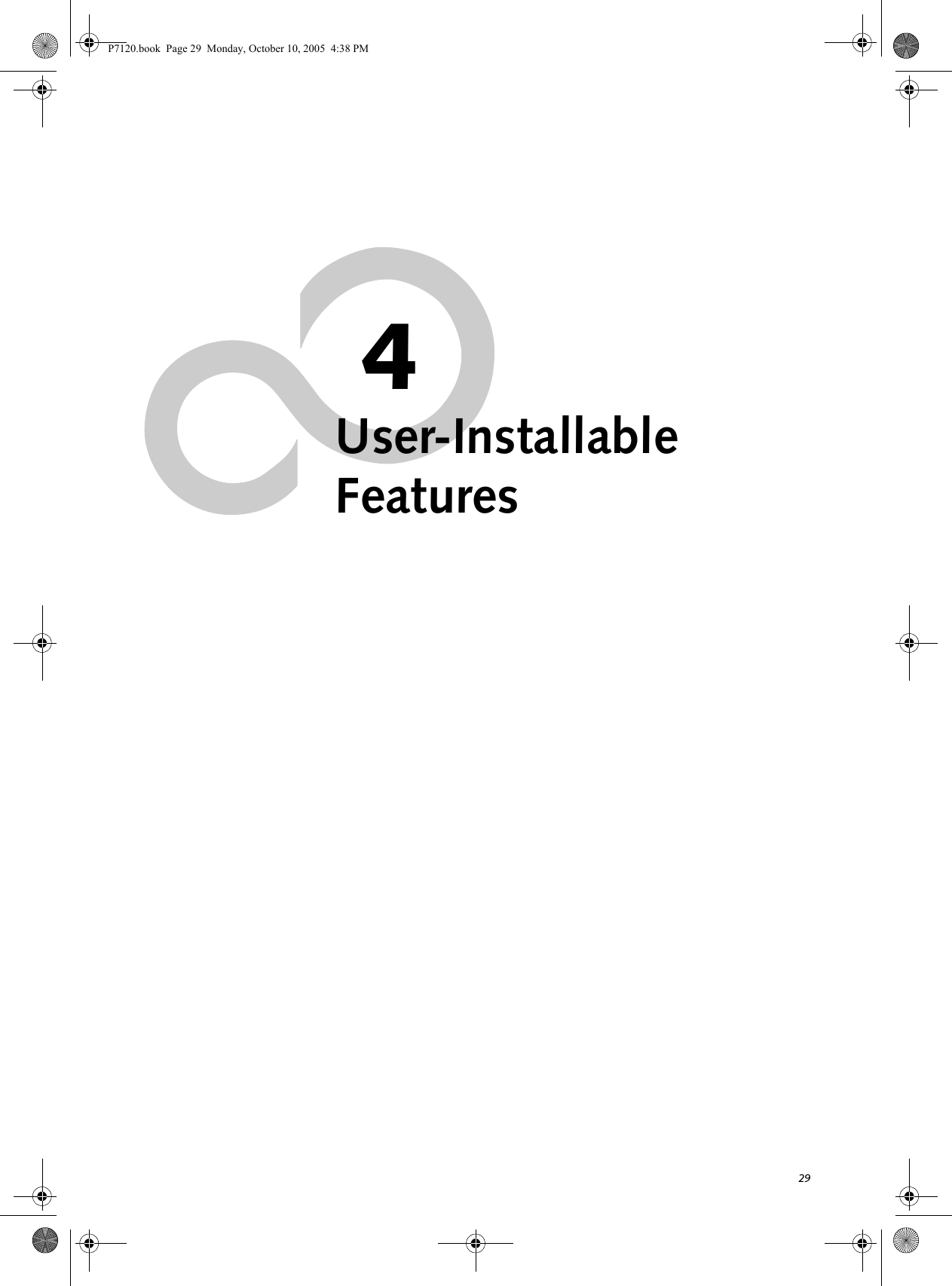

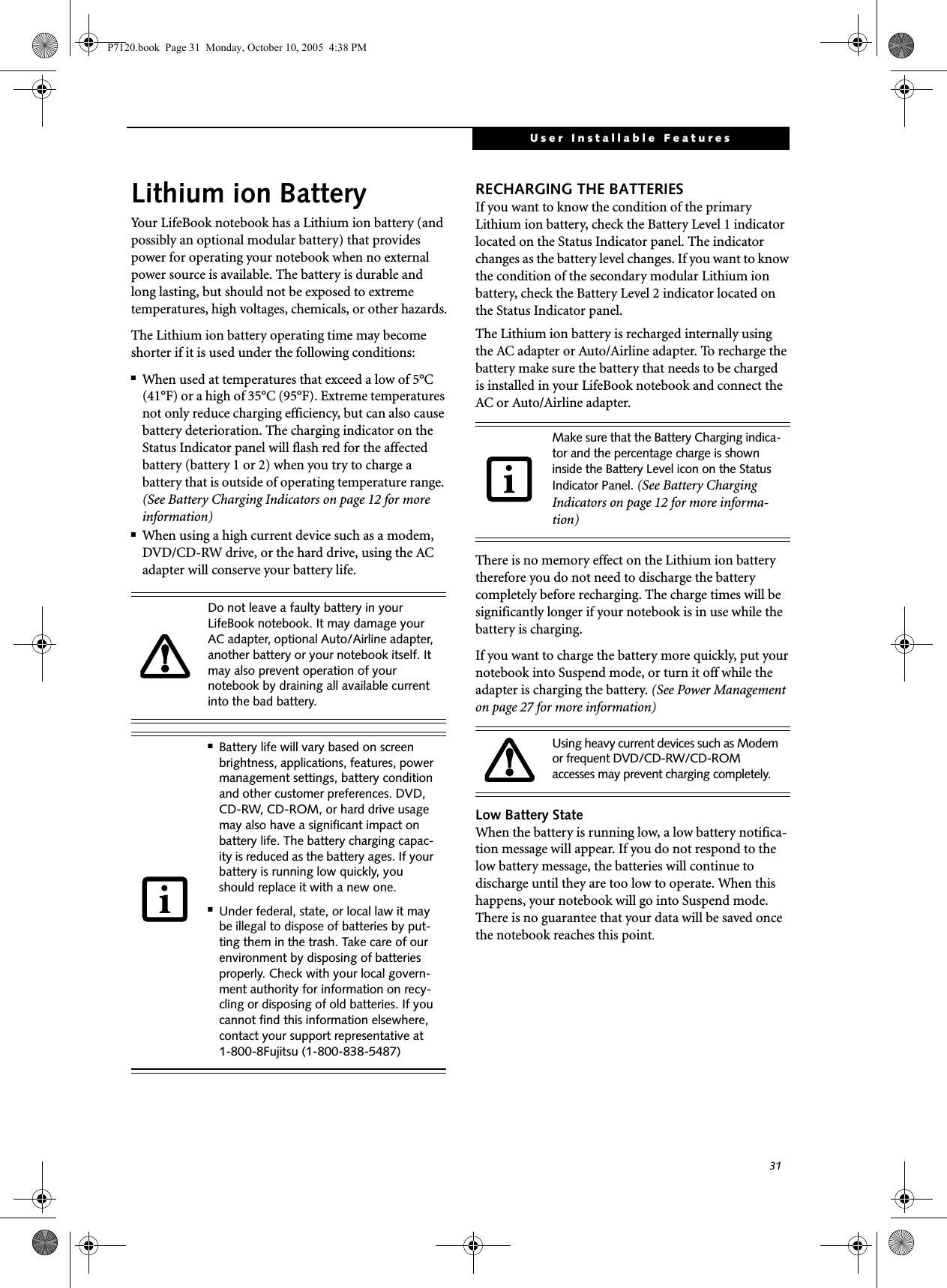
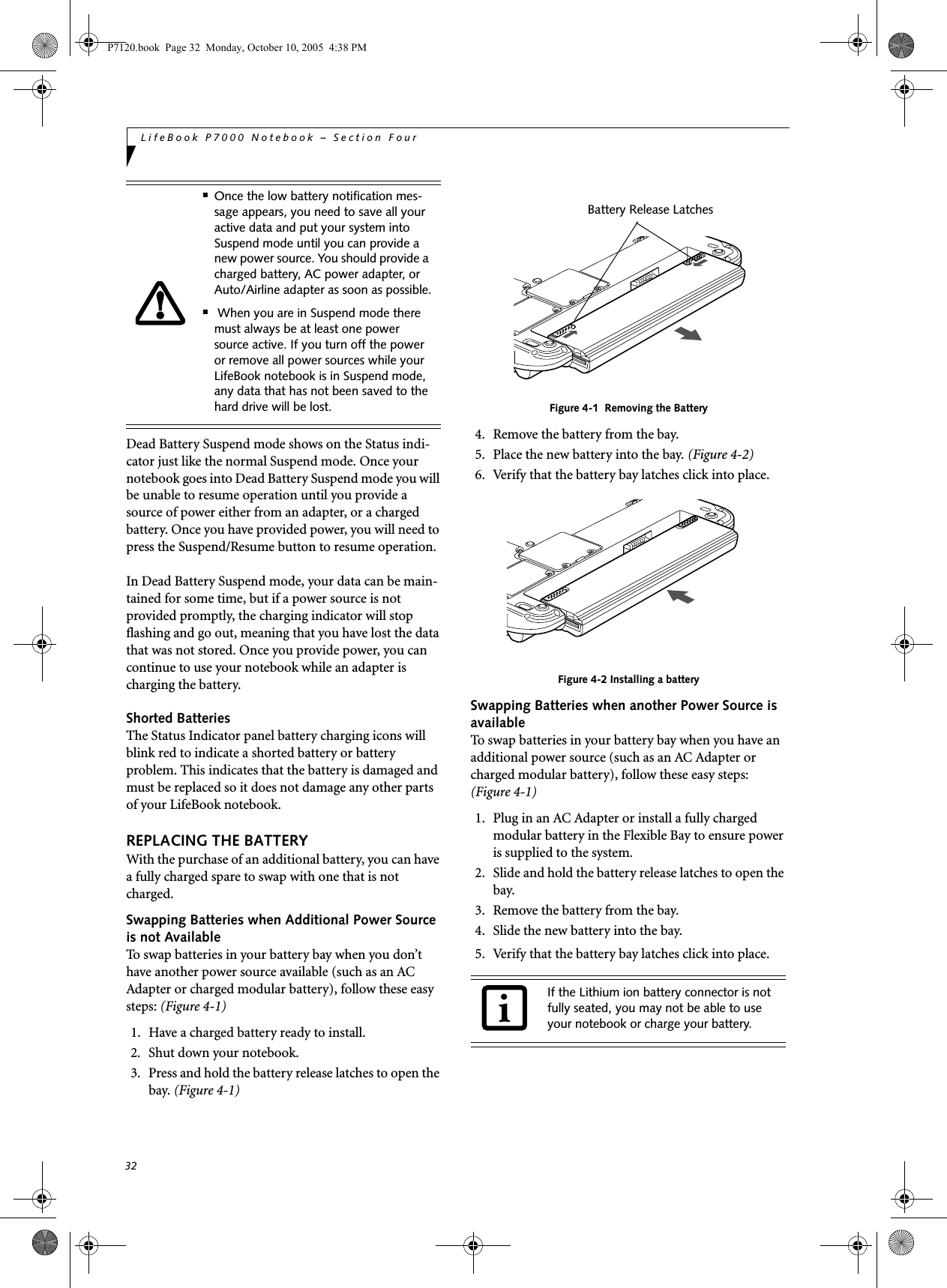
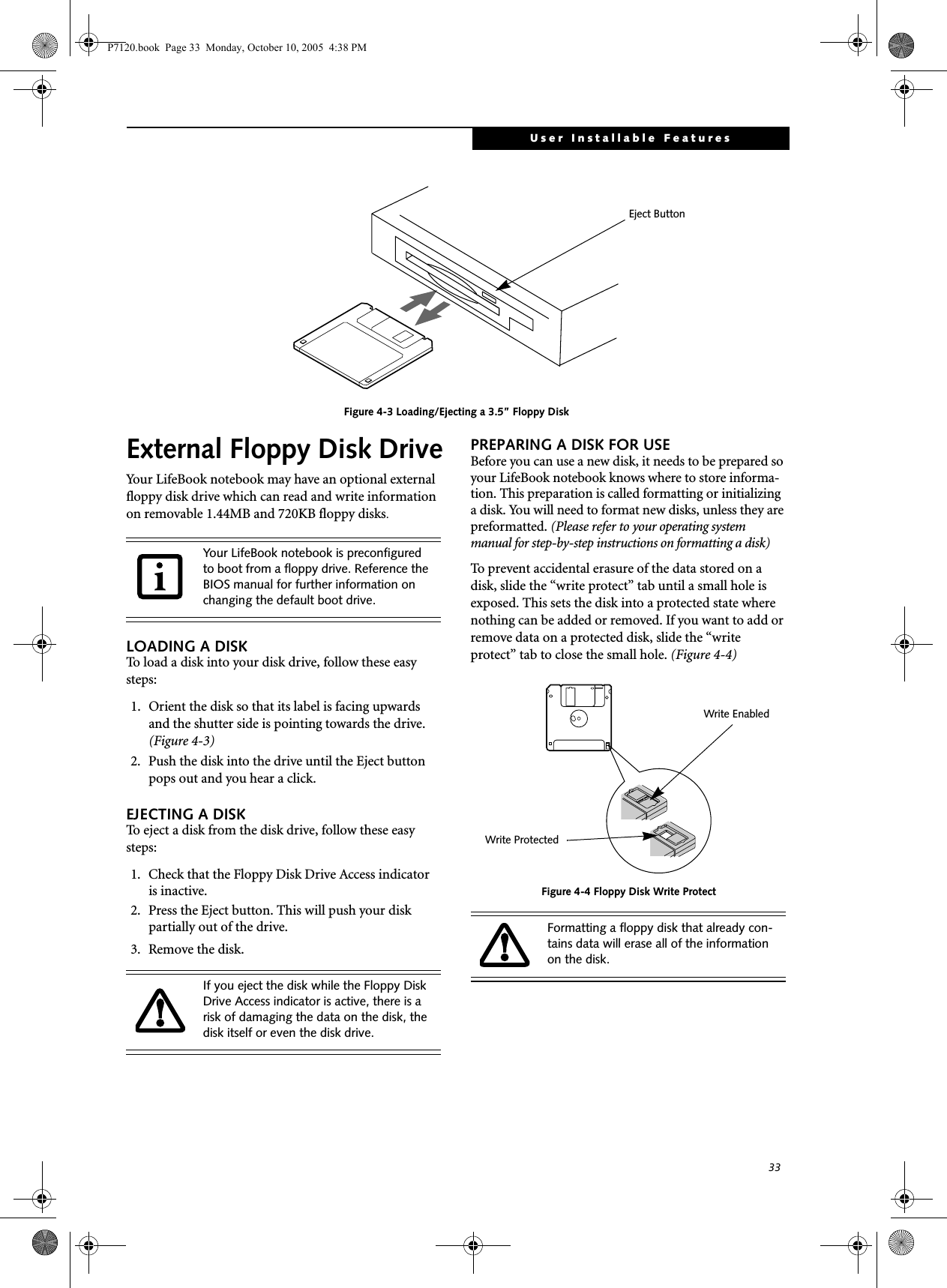
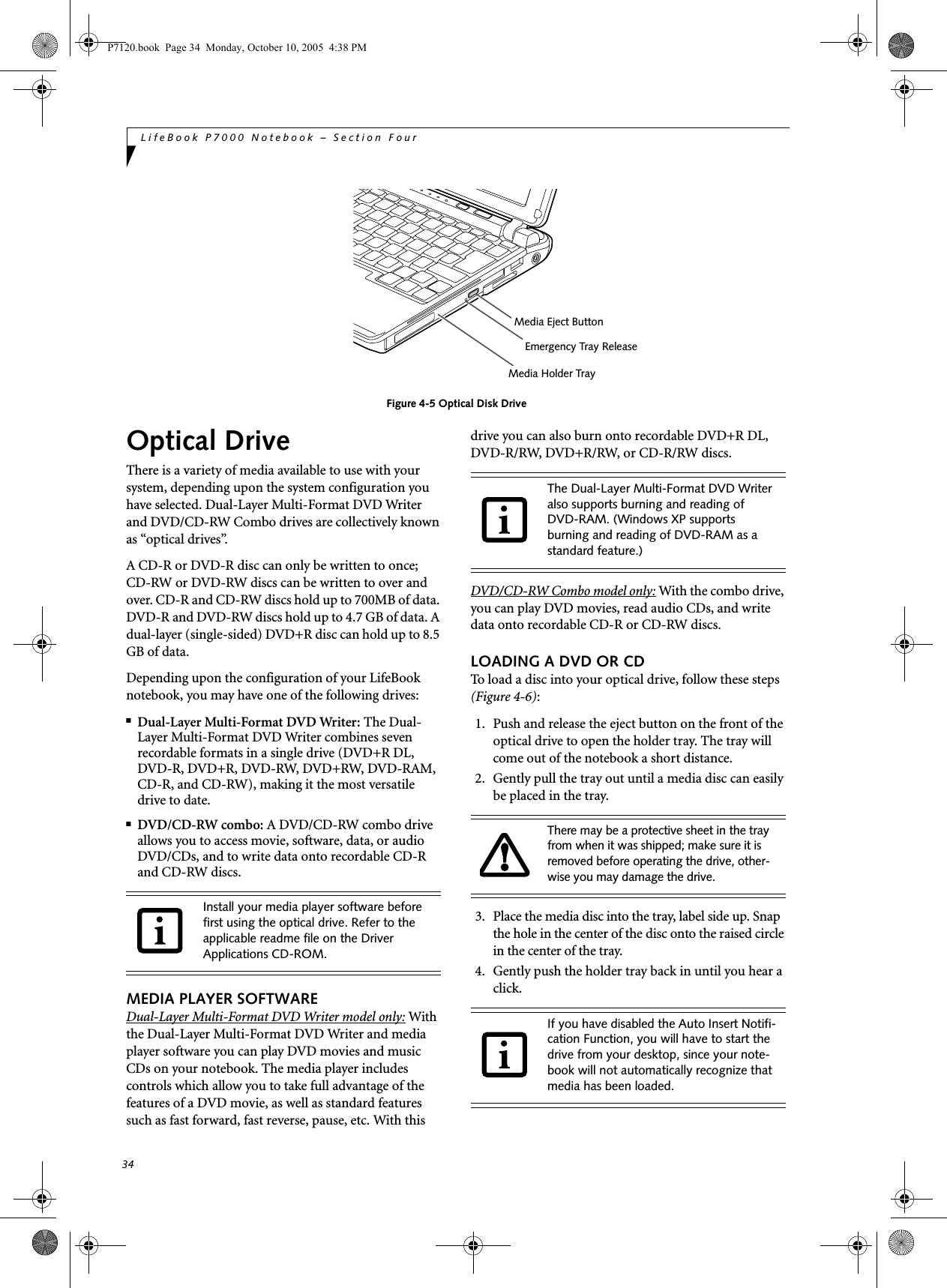
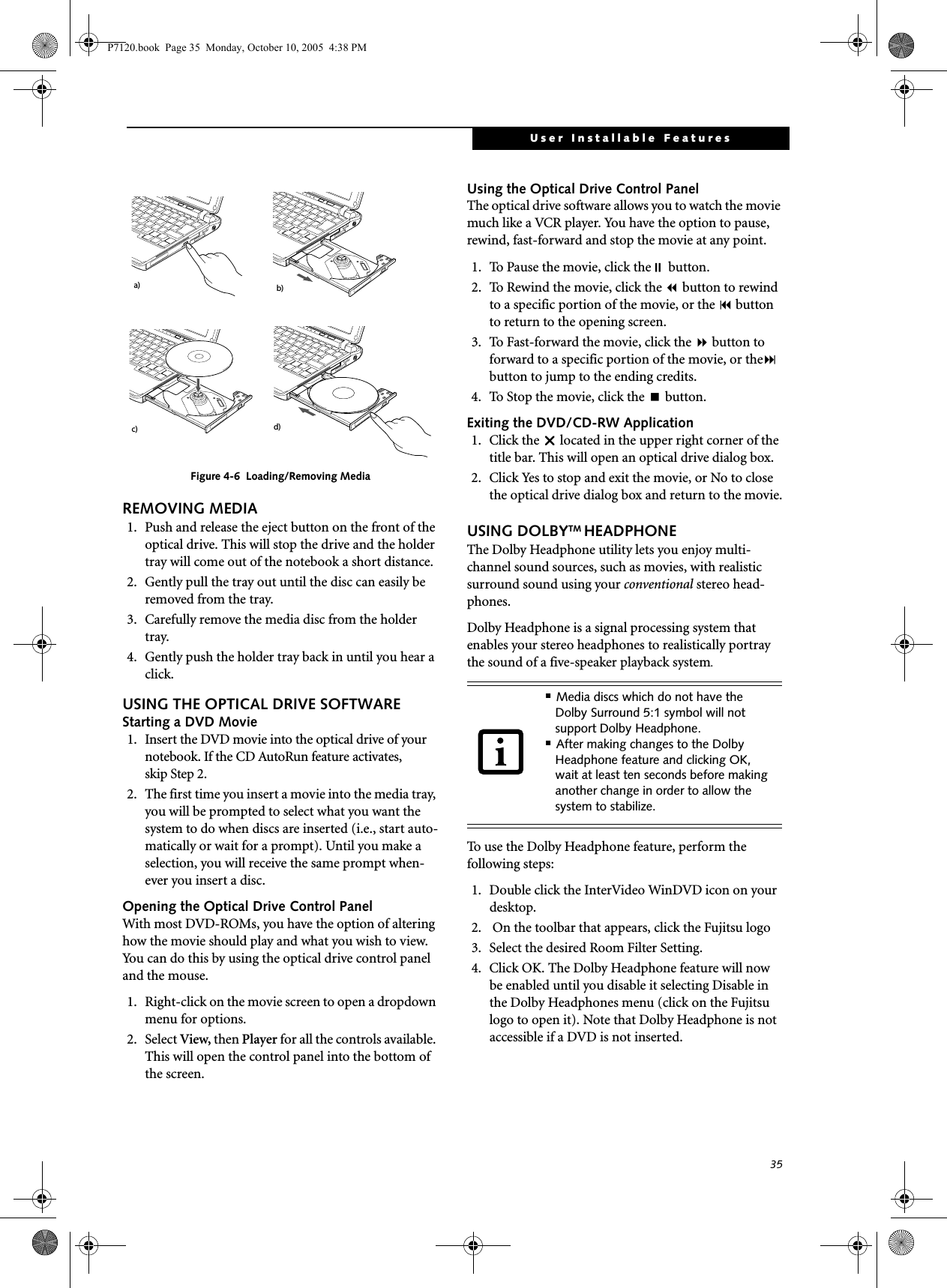
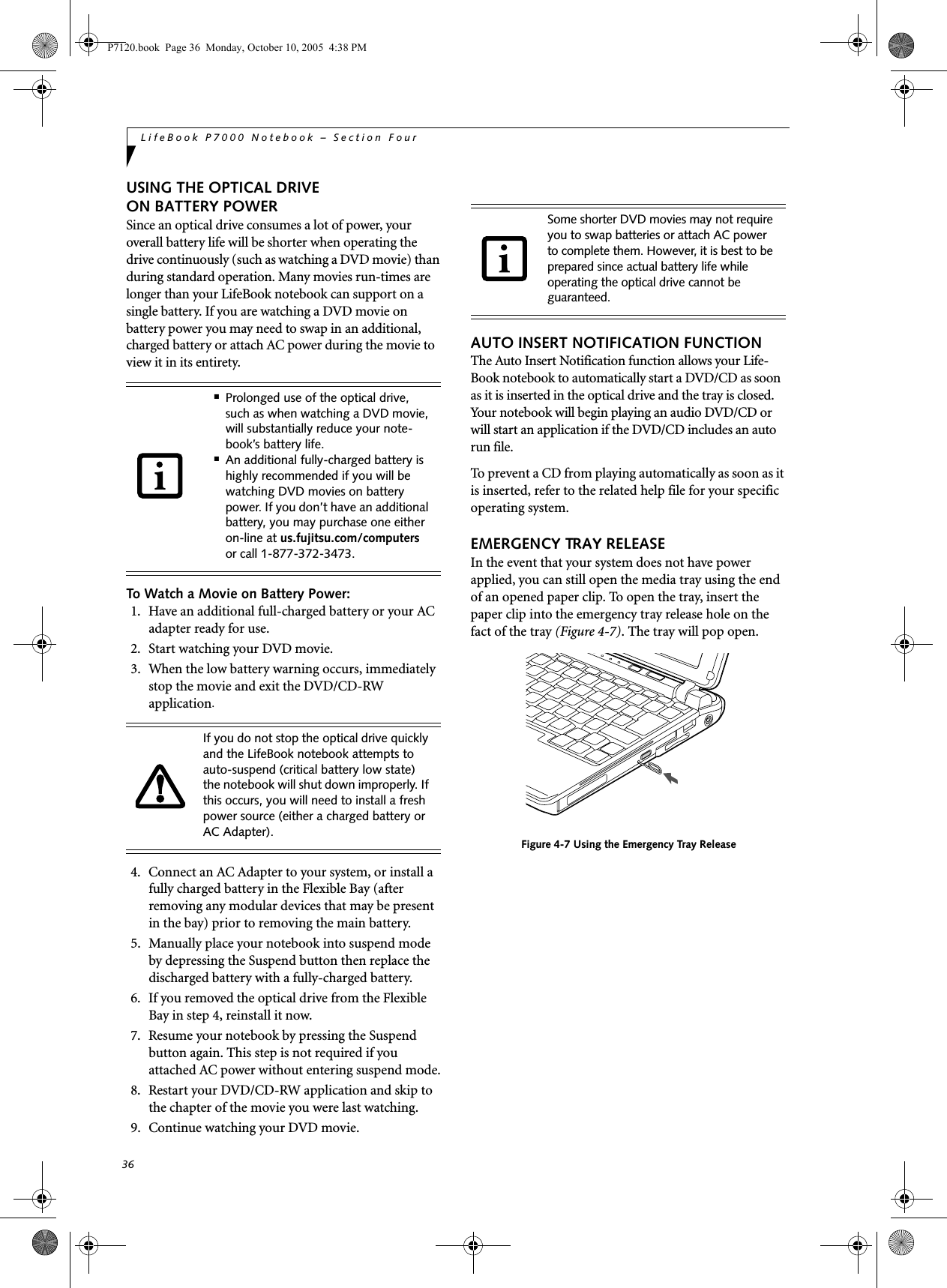
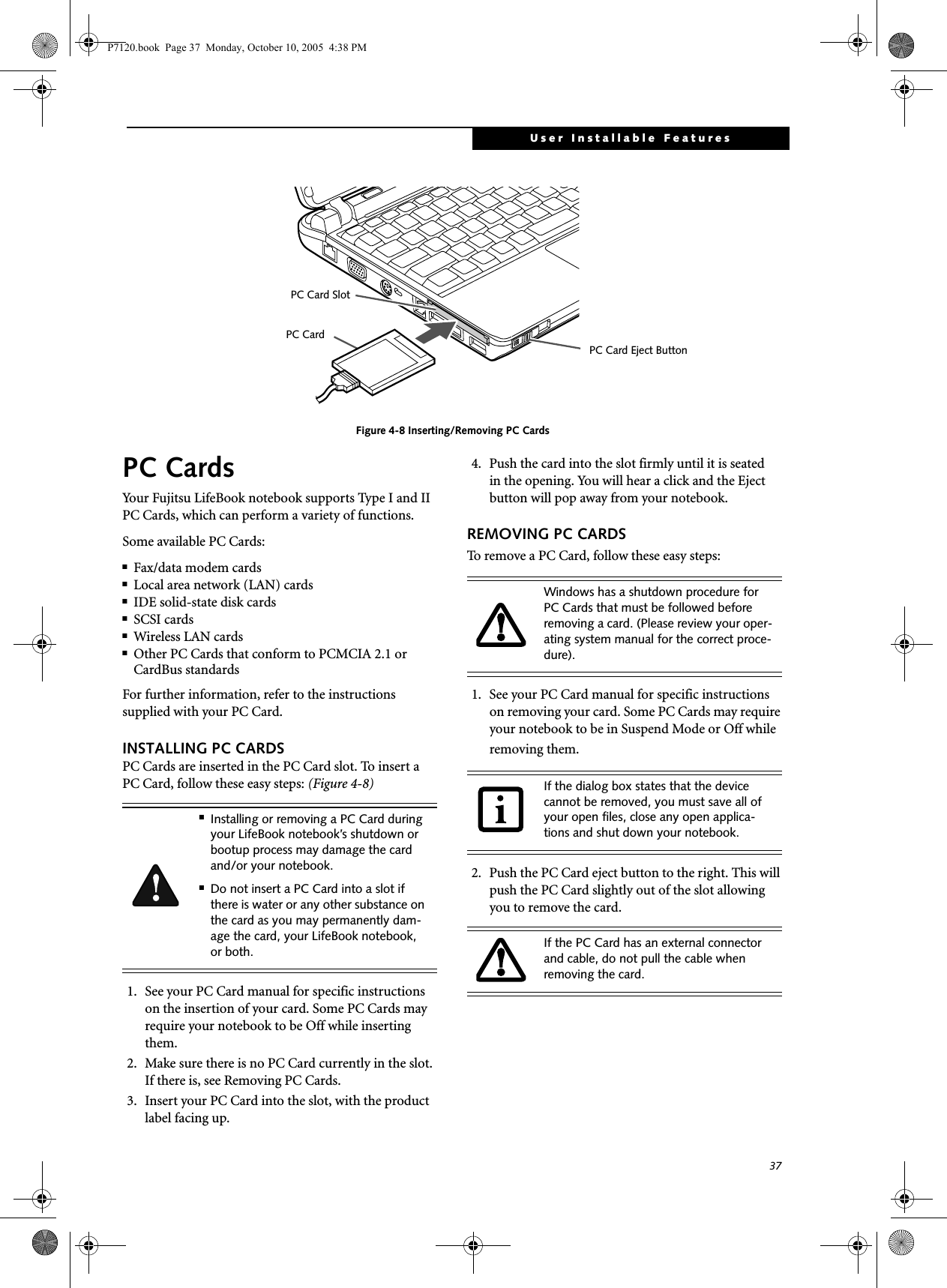
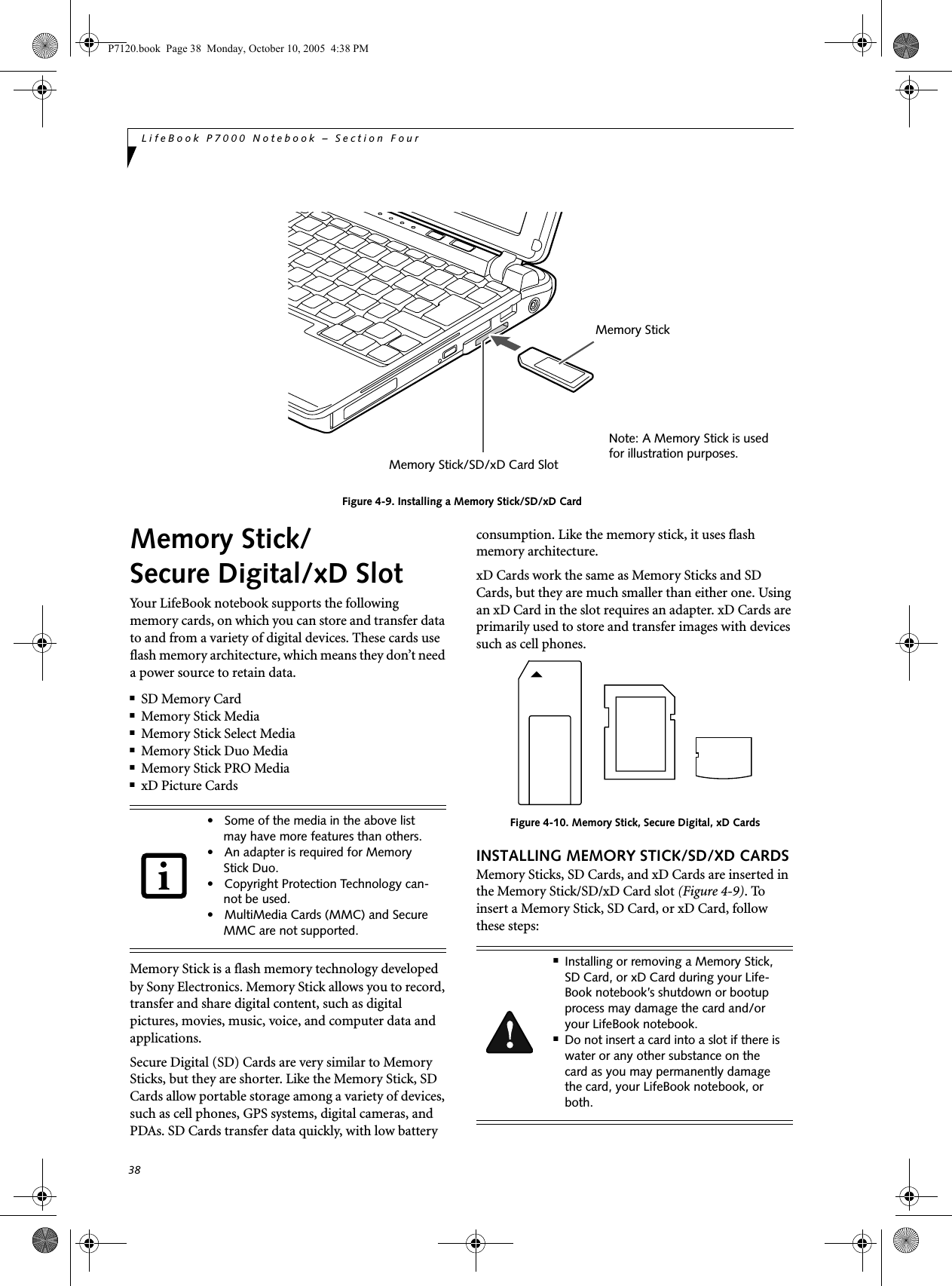
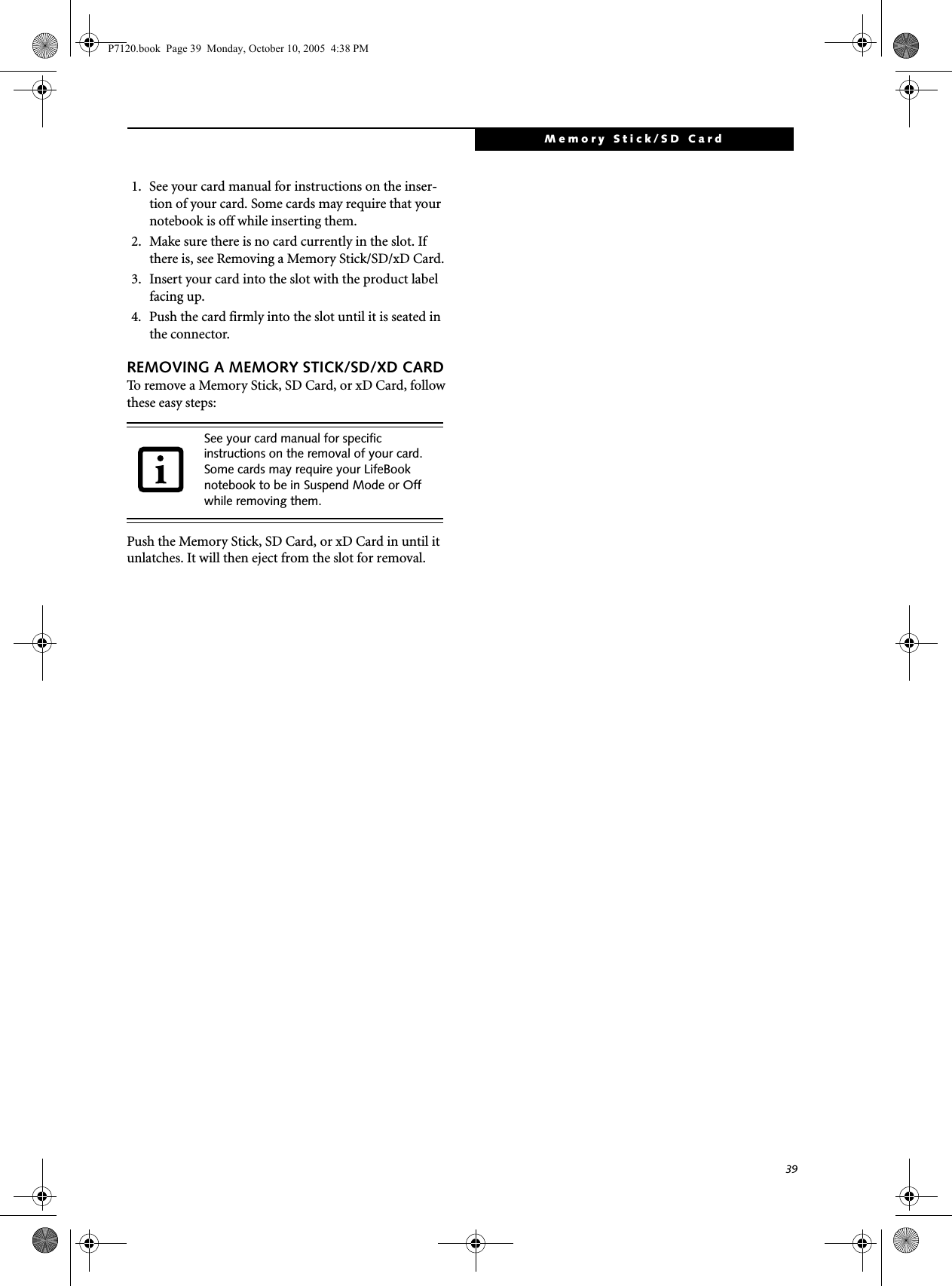
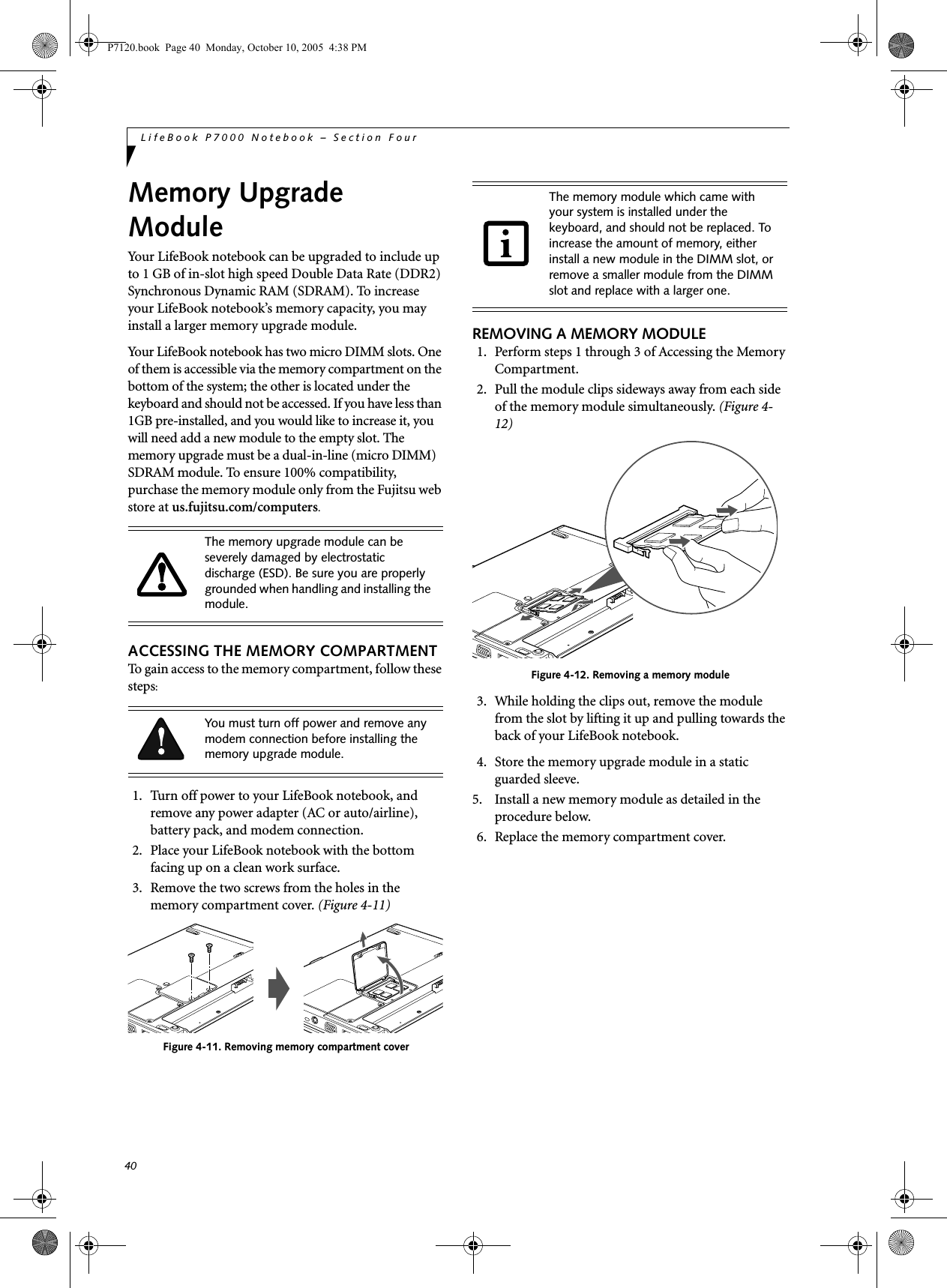
![41User Installable FeaturesINSTALLING A MEMORY MODULE1. Align the connector edge of the memory upgrade module, chip side up, with the connector slot in the compartment. (Figure 4-13)Figure 4-13. Aligning the memory moduleFigure 4-14. Installing a memory module2 . Insert the memory upgrade module at a 45o angle and press it firmly onto the connector. (Figure 4-14)3. Press the memory upgrade module down into the compartment until it locks underneath the retaining clip. You will hear a click when it is properly in place. (Figure 4-13)CHECKING THE MEMORY CAPACITYOnce you have changed the system memory capacity by replacing the installed module with a larger one, be sure to check that your notebook has recognized the change.Check the memory capacity by clicking [Start] -> Settings -> Control Panel, then double-clicking the System icon. Select the General tab and check the amount of memory under “Computer:”.There may be a variation between the actual memory size and what is displayed. This is due to the fact that your system uses a video graphics chip which dynami-cally allocates system memory to accelerate graphics performance. Up to 128 MB of memory is dynamically shared on an as-needed basis using Dynamic Video Memory Technology (DVMT).The memory upgrade module is not something you routinely remove from your LifeBook notebook. Once it is installed, you should leave it in place unless you want to increase system memory capacity.Module ClipIf the total memory displayed is incorrect, check that your memory upgrade module is properly installed. (If the module is properly installed and the capacity is still not correctly recognized, see Trouble-shooting on page 65.P7120.book Page 41 Monday, October 10, 2005 4:38 PM](https://usermanual.wiki/Fujitsu-Client-Computing/WB0045.USERS-MANUAL/User-Guide-725861-Page-50.png)
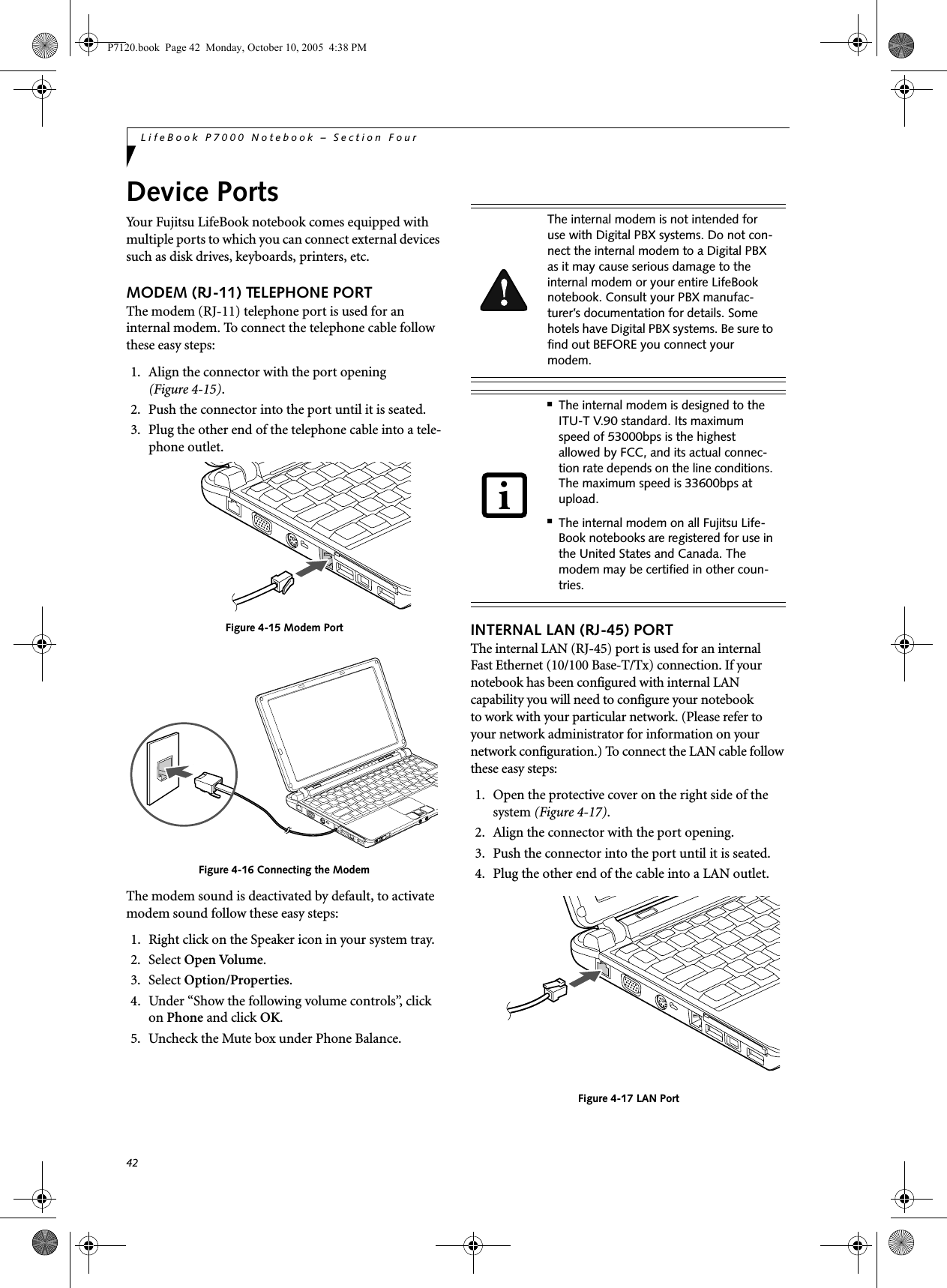

![44LifeBook P7000 Notebook – Section FourMICROPHONE JACKThe microphone jack allows you to connect an external mono microphone. The microphone jack is located on the front of the system. (Figure 4-21) Your microphone must be equipped with a 1/8”(3.5 mm) mono mini-plug in order to fit into the microphone jack of your note-book. In order to connect a microphone follow these easy steps: 1. Align the connector with the port opening.2. Push the connector into the port until it is seated.EXTERNAL VIDEO PORTThe external video port allows you to connect an external monitor or LCD projector. In order to connect a monitor, follow these easy steps: 1. Open the protective cover on the right side of the system (Figure 4-22).2. Align the connector with the port opening.3. Push the connector into the port until it is seated. Figure 4-22 Installing the External Monitor CablePressing the [Fn] + [F10] keys allows you to change your selection of where to send your display video. Each time you press the key combination, you will step to the next choice, starting with the built-in display panel only, moving to the external monitor only, finally moving to both the built-in display panel and an external monitor.P7120.book Page 44 Monday, October 10, 2005 4:38 PM](https://usermanual.wiki/Fujitsu-Client-Computing/WB0045.USERS-MANUAL/User-Guide-725861-Page-53.png)
